Mary Anne Yarde's Blog: The Coffee Pot Book Club , page 138
May 16, 2019
Now is your chance to vote for your favourite book cover for May over on The Coffee Pot Book Club! #BookCovers #CoffeePotBookClub
The Coffee Pot Book ClubBook Cover of the Month
 Readers' Choice!May 2019
Readers' Choice!May 2019
Now is your chance to vote for your favourite book cover for May. All you need to do is pop the number of the book cover you like along with the book title in the comment section at the bottom of the page.
The winner will be announced on the 30th May.
★ 1 ★The Highlander's Lost LadyBy Anna Campbell

★ 2 ★Mira's WayBy Amy Maroney

★ 3 ★Killing The HangmanBy Ellie Midwood

★ 4 ★The Italian CoupleBy J.R. Rogers
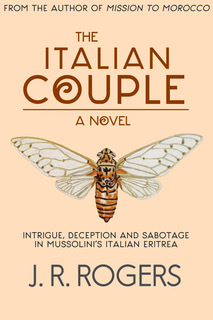
★ 5 ★Destiny of a WarriorBy Mary Morgan

★ 6 ★The Earl's Runaway GovernessBy Catherine Tinley

★ 7 ★Code Name CamilleBy Kathryn Gauci

★ 8 ★An Officer's VowBy Penny Hampson
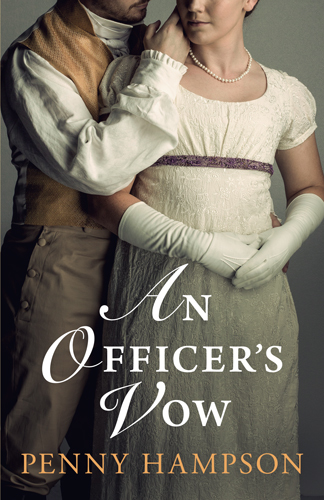
★ 9 ★Conflict on the YnagtzeBy Greg Kater
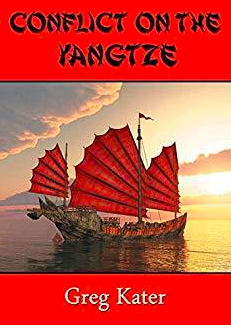
★ 10 ★The Silent WomanBy Terry Lynn Thomas

★ 11 ★Brandon: Tudor KnightBy Tony Riches

★ 12 ★A Modest IndependenceBy Mimi Matthews

★ 13 ★A Jacob the TrumpeterBy Robert Barclay

★ 14 ★Sauce for the Gander
By Jayne Davis
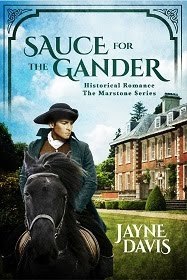
★ 15 ★
Arthur Dux BellorumBy Tim Walker

★ 16 ★
Severed KnotBy Cryssa Bazos

★ 17 ★
The Strongman and the MermaidBy Kathleen Shoop

★ 18 ★
A Murderous MaladyBy Christine Trent

★ 19 ★
RepentanceBy Andrew Lam

★ 20 ★
Smoke in her EyesBy Anna Belfrage

★ 21 ★
PassengersBy Elizabeth Collums

★ 22 ★
Blood and RosesBy Catherine Hokin

★ 23 ★
Listen to the Wind
By Susanne Dunlop

★ 24 ★Bright AxeBy Christine Hancock

★ 25 ★Scribblers TalesBy Mary Ann Bernal

★ 26 ★Victoria to VikingsBy Trisha Hughes

★ 27 ★A King Under SiegeBy Mercedes Rochelle

★ 28 ★The Red FlagBy Julia Maiola
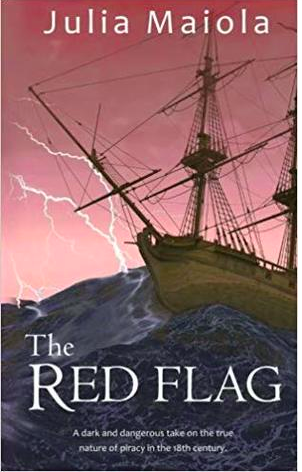
★ 29 ★Will of a TigerBy Iris Yang

★ 30 ★Al Capone at the Blanche Hotel
By Linda Bennett Pennell

Good Luck!!
 Readers' Choice!May 2019
Readers' Choice!May 2019Now is your chance to vote for your favourite book cover for May. All you need to do is pop the number of the book cover you like along with the book title in the comment section at the bottom of the page.
The winner will be announced on the 30th May.
★ 1 ★The Highlander's Lost LadyBy Anna Campbell

★ 2 ★Mira's WayBy Amy Maroney

★ 3 ★Killing The HangmanBy Ellie Midwood

★ 4 ★The Italian CoupleBy J.R. Rogers

★ 5 ★Destiny of a WarriorBy Mary Morgan

★ 6 ★The Earl's Runaway GovernessBy Catherine Tinley

★ 7 ★Code Name CamilleBy Kathryn Gauci

★ 8 ★An Officer's VowBy Penny Hampson

★ 9 ★Conflict on the YnagtzeBy Greg Kater

★ 10 ★The Silent WomanBy Terry Lynn Thomas

★ 11 ★Brandon: Tudor KnightBy Tony Riches

★ 12 ★A Modest IndependenceBy Mimi Matthews

★ 13 ★A Jacob the TrumpeterBy Robert Barclay

★ 14 ★Sauce for the Gander
By Jayne Davis

★ 15 ★
Arthur Dux BellorumBy Tim Walker

★ 16 ★
Severed KnotBy Cryssa Bazos

★ 17 ★
The Strongman and the MermaidBy Kathleen Shoop

★ 18 ★
A Murderous MaladyBy Christine Trent

★ 19 ★
RepentanceBy Andrew Lam

★ 20 ★
Smoke in her EyesBy Anna Belfrage

★ 21 ★
PassengersBy Elizabeth Collums

★ 22 ★
Blood and RosesBy Catherine Hokin

★ 23 ★
Listen to the Wind
By Susanne Dunlop

★ 24 ★Bright AxeBy Christine Hancock

★ 25 ★Scribblers TalesBy Mary Ann Bernal

★ 26 ★Victoria to VikingsBy Trisha Hughes

★ 27 ★A King Under SiegeBy Mercedes Rochelle

★ 28 ★The Red FlagBy Julia Maiola

★ 29 ★Will of a TigerBy Iris Yang

★ 30 ★Al Capone at the Blanche Hotel
By Linda Bennett Pennell

Good Luck!!
Published on May 16, 2019 23:00
May 15, 2019
#BookReview — CAY - Rosevetha’s Curse:The Civilis Saga Part #3 by Peter Baggott #HistoricalFiction #AncientRome

CAY - Rosevetha’s Curse:
The Civilis Saga Part #3
By Peter Baggott
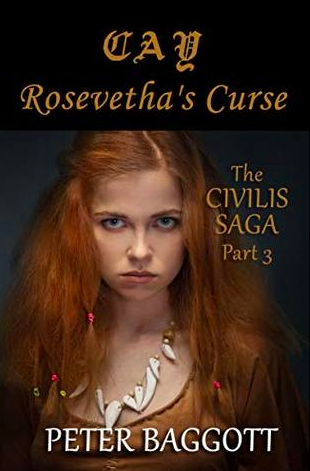
Champion of Teutoburger Wald he craves a son in a barren marriage and seeking a resolution he approaches Witold. She guarantees him a son. But after the death of his wife, he seeks retribution against Roman sympathizers. Witold warns him against harming a fellow seer or he will face dire consequences. Twice he will escape the same Roman, but on the third occasion, there will only be one winner.
 “Twice you will meet the same Roman, and he will escape, but when he comes looking for the final Eagle, my Eagle, you and your son will help defend it.”
“Twice you will meet the same Roman, and he will escape, but when he comes looking for the final Eagle, my Eagle, you and your son will help defend it.”To lose an Eagle is shameful. But, to lose three Eagles is nothing short of a disgrace.
It was only a matter of time before the Romans returned to this land and sought retribution for those who had been slaughtered and to reclaim the Eagles that had been taken.
Agi of the Chauci had fought alongside Arminius and had witnessed the taking of the Eagles from the hands of the hated Romans, but it was not that which had taken him into the forest to seek the wisdom of the seer, Witold. He wanted to know if he would ever have a son, an heir. The seer’s answer is enough to satisfy Agi, but the warning that comes with it is not so easy to comprehend. Witold warns him of another — a woman just like her, a seer. The destiny of his son will depend on how he treats this woman.
On hearing the news of the lost Eagles at The Battle of the Teutoburg Forest, Caesar Augustus cried,“Give me back my legions.” However, such was the shame of the loss that any survivors were banned from returning to Rome. The disgrace would be theirs to carry forever, and that disgrace would also be passed down to their sons. However, the sons of the lost legions come together under the watchful eye of Artorius Civilis. With his help, they would right the wrong, and win back the Eagles their fathers had lost.
CAY - Rosevetha’s Curse: The Civilis Saga Part #3, by Peter Baggott, is the powerful tale about the unforgettable Civilis family as they desperately try to navigate a world that is corrupt, treasonous, and dangerous, in order to bring honesty, loyalty and peace for their kinsman and the Empire.
CAY - Rosevetha’s Curse is one of those books where the pages practically turned themselves. I did initially wonder why Baggott dedicated over half of this novel to what is essentially a prequel, but, when I reached Part 2 of CAY - Rosevetha’s Curse, I began to understand why he chose to do this. I think the backstory gives this series, and indeed this book, a very firm foundation. The characterisation was superb, and the narrative was an absolute triumph. Baggott presents his readers with highly appealing protagonists and spine-chillingly malicious antagonists.
Baggott does not shy away from what can make for uncomfortable reading. Within these pages, we watch the making of a monster. The young Victus shows all the signs of what he is to become. He is manipulative, very charismatic and even charming when he wants to be. However, there is a very dark side to him. The first to suffer his abuse is a dog, and then the level of violence escalates as he turns this viciousness towards women. There are multiple violations of women in this story, as well as murders, but Baggott is careful to strike a balance between how he wants the characterisation of Victus to be perceived and the audience his book is aimed at.
Baggott is a master at conveying the time this book is set in. I have said it before, and I will say it again, his attention to historical detail and historical fact has to be commended. This book is luxuriantly detailed, and the historical characters have been richly brought back to life. Baggott is a born Historical Fiction writer. He nails the historical backdrop every time. Superb.
Due to the intensity of the story and the large cast of characters, I don’t think CAY - Rosevetha’s Curse: The Civilis Saga Part #3 is a standalone read. However, this series is so good that you would be doing yourself a disservice by not starting with Book 1.
The Civilis Saga is escapist Historical Fiction at its very best. I Highly Recommend.
Review by Mary Anne YardeThe Coffee Pot Book Club.
Pick up your copy of
CAY - Rosevetha’s Curse:
Amazon UK • Amazon US
Peter Baggott
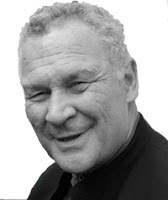 Peter Baggott is a debut author with a deep interest in Roman history. He has served in three uniformed employments and is very familiar with Roman tactics which are still used in everyday life: shield tactics and skills – testudo being much used in the Police and Prison Service. Peter chose for his writing this historical genre because of his innate interest in the subject and having been born in the Roman city of Lindvm, modern day Lincoln. In his teens, on a daily basis, while delivering newspapers, Peter traversed the exposed Roman remains from The Steep to the Newport Arch, the only full Roman archway in Great Britain. While working in a local hotel close to the ruins he utilised this knowledge to become a self-appointed guide to visitors from far and wide and has continued to keep up to date with local finds. There are many stories surrounding the infamous Legio IX Hispana, who were based in Lindvm, their disappearance has inspired his continuing interest in all things Roman. Peter has also visited numerous Roman sites, both in the UK and in Europe and has used original Roman historical sources of Tacitus, Suetonius and Dio, Google Maps for distancing and location, Wikipedia and several archaeological online sources. Thus, he tries to keep abreast with new finds upgrading his work accordingly.
Peter Baggott is a debut author with a deep interest in Roman history. He has served in three uniformed employments and is very familiar with Roman tactics which are still used in everyday life: shield tactics and skills – testudo being much used in the Police and Prison Service. Peter chose for his writing this historical genre because of his innate interest in the subject and having been born in the Roman city of Lindvm, modern day Lincoln. In his teens, on a daily basis, while delivering newspapers, Peter traversed the exposed Roman remains from The Steep to the Newport Arch, the only full Roman archway in Great Britain. While working in a local hotel close to the ruins he utilised this knowledge to become a self-appointed guide to visitors from far and wide and has continued to keep up to date with local finds. There are many stories surrounding the infamous Legio IX Hispana, who were based in Lindvm, their disappearance has inspired his continuing interest in all things Roman. Peter has also visited numerous Roman sites, both in the UK and in Europe and has used original Roman historical sources of Tacitus, Suetonius and Dio, Google Maps for distancing and location, Wikipedia and several archaeological online sources. Thus, he tries to keep abreast with new finds upgrading his work accordingly.Connect with Peter: Website • Twitter.
Published on May 15, 2019 23:00
May 14, 2019
Author, Catherine Hokin, is sharing some fabulous Historical Fiction writing tips #amwriting #HistoricalFiction #Research @cathokin
A Recipe for ResearchBy Catherine Hokin
Being from the North of England, I am firmly of the belief that all meals can be substantially improved by a liberal slathering of gravy or custard. Pour it on, bring some more should be my family motto. Sadly, anyone who read the first draft of my first novel would be forgiven for thinking that motto applied to the way I used my research.

We’ve all read/written/wept and run away from it: the novel that turned into a thesis. (Writing that sentence, I’m imagining it underscored by a howl from a fifties B-movie). It’s easily done. No one writes historical fiction unless they have a passion for research of the most convoluted kind. There is, however, a huge difference between sharing what’s needed and, let’s be honest, showing off.
The tips below are intended to move you out of PhD territory and into the cracking read your idea is. It’s mine, it’s not definitive, but it is based on an awful lot of research…
The Good Stuff

Start with a purpose and a plan. Your novel isn’t about the Wars of the Roses, or about the American Civil War. It’s a spotlight on an aspect, an event or a character inside those parameters, and that’s your starting focus. Start too wide and you’ll literally lose the plot.
Get organised. Whether your system is notebooks or post-its or files, be able to find things – you can waste a lot of time trying to dig up that great note you made on that thing you mustn’t forget 3 months after you made it.Check your sources. Whether it’s primary or secondary material, know if there’s an agenda. If something sounds odd, check what other sources say. Same if there’s a conflict, which frequently happens. None of that is bad, it’s actually what you want as long as you use the discrepancies carefully – hopefully they lead to the gaps where your story takes root.
Let those gaps speak. We often know what was done, it can be harder to find out why, or by who, or how they felt when they did/didn’t do it. That’s where your story lies: the facts are your skeleton; a good writer gets down inside them.
Immerse yourself. You need to know everything about your period. Walk its streets and hear its sounds and taste the life there so it becomes bigger than your real world. Watch films, read novels, listen to music, look at paintings, set up a Pinterest board. If you can travel there, that’s great but it isn’t essential – places change dramatically so you’ll be back to the sources anyway.
Keep doing it. Research is an ongoing process – after the initial immersion period you’ll still need to go back for details as your story progresses. Sometimes you don’t know what you need to know until the plot takes you there.
Know when to stop. You’re a writer, at some point you need to take the plunge and write.
Which leads neatly into…
The Stuff that will Weigh You Down
The rabbit holes. At some point you’ll turn into Alice, endlessly falling. Ask yourself: do I need to know all this or have I got side-tracked? Then ask the better question: will my reader care? Climb out, and repeat.
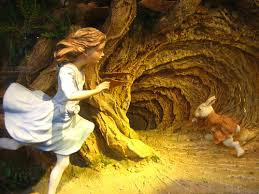 Down the Rabbit Hole — Valerie Hinojosa.
Down the Rabbit Hole — Valerie Hinojosa.And closely linked to the above – remember, just because you know something doesn’t mean that your reader should. If you can’t help yourself, task a beta reader to check where they got bored, where a quick explanation turned into an essay. Where the story stopped moving. Think about how endless exposition can ruin a film by breaking the tension and apply.And closely linked again – just because you know something, your character might not, or should not. We have the benefit of hindsight and Google – an ordinary girl in occupied Paris in 1941 wouldn’t have a clue what was happening in Germany, she might not know what was happening in France. A soldier wouldn’t necessarily know the bigger picture. Communication in the past was slow and easily disrupted – which is why we like setting our novels there.
Do not play fast and loose with the facts. This should be in red. If something happened on a given date, it happened on that date. If someone died before you want them to do something, hard luck. There’s a huge difference between finding a gap and working something plausible into it, and making the impossible up. If in doubt please ask me my views on the recent Mary Queen of Scots film – no one I know will listen anymore. Remember you’re not a historian – people are reading your story to be entertained (and sometimes to check what they know/thought). Get things wrong and you risk their trust; bore them and they won’t come back. So, there you have it – love your research but use it sparingly. It’s the seasoning to your work not the sauce. (Bad puns the author’s own).

Blood and Roses
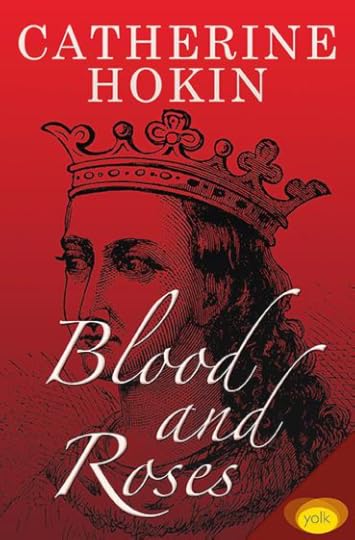
1460
The English Crown – a bloodied, restless prize. The one contender strong enough to hold it? A woman. Margaret of Anjou: a French Queen in a hostile country, born to rule but refused the right, shackled to a King lost in a shadow-land.When a craving for power becomes a crusade, when two rival dynasties rip the country apart in their desire to rule it and thrones are the spoils of a battlefield, the stakes can only rise. And if the highest stake you have is your son?You play it.
Pick up your copy of
Blood and Roses
Amazon UK • Amazon US
Catherine Hokin
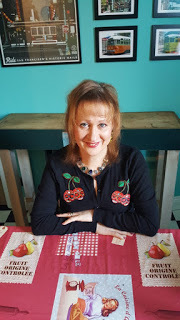 Catherine is a Glasgow-based author whose debut novel, Blood and Roses brings a new perspective to the story of Margaret of Anjou (1430-1482, wife of Henry VI) and her pivotal role in the Wars of the Roses. Catherine also writes short stories which have been placed in competitions (including 1st prize in the 2019 Flash 500 ShortStory Competition) and published in iScot, Myslexia and Writers Forum magazines. She blogs monthly for TheHistory Girls and is represented by Tina Betts of the Andrew Mann Literary Agency.
Catherine is a Glasgow-based author whose debut novel, Blood and Roses brings a new perspective to the story of Margaret of Anjou (1430-1482, wife of Henry VI) and her pivotal role in the Wars of the Roses. Catherine also writes short stories which have been placed in competitions (including 1st prize in the 2019 Flash 500 ShortStory Competition) and published in iScot, Myslexia and Writers Forum magazines. She blogs monthly for TheHistory Girls and is represented by Tina Betts of the Andrew Mann Literary Agency. Connect with Catherine: Website • Facebook • Twitter.
Published on May 14, 2019 23:00
#HistoricalFiction author, Elizabeth Collums, is talking about the inspiration behind her fabulous book — Passengers #Giveaway @hfvbt
Historical Fiction Virtual Blog Tours Presents…PassengersBy Elizabeth Collums
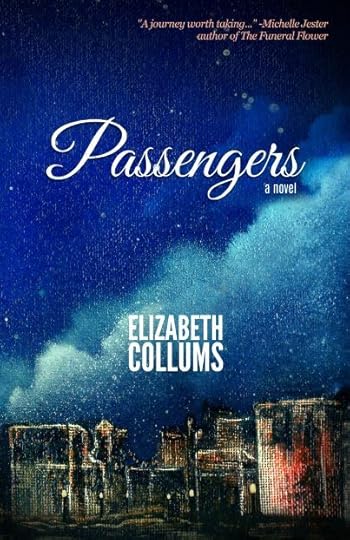
During the Great Irish Famine the Ewing family made their way from their rural cottage to the village of Highland Way. Annie, the oldest daughter was left to care for her mother and younger sister after her father left to find work in Dublin.A mysterious letter arrives from America forcing Annie, Lily, and Katy into a harrowing journey. The hand written note not only will expose deep secrets, it will also challenge the strength and fortitude of the Ewing women, leading each member into their own soul searching voyage.Follow this extraordinary passage that begins in Ireland and leads each woman to uncover their own courage and truths in this new world.
An author’s inspiration…
There have been hundreds, if not thousands, of threads of experiences that drew me to put pen to paper just to, if nothing else, leave some sort of tangible legacy for my children and grandchildren. There have been moments of feeling so paralyzed with fear of failure that I stayed stuck long beyond a reasonable time of prayer and deliberation. And there have been times when I blew through things based on pure emotion and suffered greatly for my impatience. And I wanted them to know, not in an autobiographical sense, but more in my mind's eye of what works and what doesn't work life lessons, no matter what decade you might find yourself in. For, I believe, time and the calendar doesn't change what's right or wrong.But, there's also something for me, about writing, that frees my soul. I've written countless letters and never mailed, but felt lighter just by doing so. And this book allowed me to do just that.The emotionally detached mother that I waited decades to "appreciate her now with me" finally drifted into the world called dementia. All the years of hope and prayer had now been sealed shut. She would never give me what I desperately longed and waited for. Honestly, I felt that she was, in a way, hopelessly disappointed in the way her life turned out and I bore the brunt of constantly trying to fix it. Al least now, I was just another stranger that she was glad to see. But, I could write a different story with a different ending; one full of those that came before me. My grandparents and great grandparents who truly had challenges and took so many risks for a better life and for that I will always be grateful. For my ancestors really did come from Ireland during the Great Famine and made their home in Canton, Mississippi. And I have so many wonderful memories of my visits with them.So on New Year’s Day, how appropriate, January, 2016, I got up off the couch, picked up a pen and began this heartfelt journey of freeing my soul, but this time I mailed it.
Giveaway
During the Blog Tour, we will be giving away two $20 Amazon Gift Cards! Enter HERE!Giveaway Rules• Giveaway ends at 11:59 pm EST on May 17th. You must be 18 or older to enter.
• Giveaway is open to US only.
• Only one entry per household.
• All giveaway entrants agree to be honest and not cheat the systems; any suspicion of fraud is decided upon by blog/site owner and the sponsor, and entrants may be disqualified at our discretion.
• The winner has 48 hours to claim prize or new winner is chosen.
Pick up your copy of PassengersAmazon UK • Amazon US
Elizabeth Collums
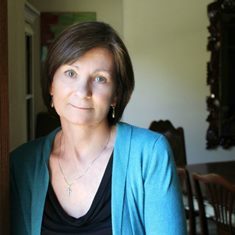 Ann C. Purvis, chose to publish her first novel under her birth name, Elizabeth Collums; this is her true roots and where she has drawn from many of the experiences she wrote about. She lives in Denham Springs, Louisiana and enjoys DIY projects. She has two daughters, a stepdaughter, son-in-law, two amazing granddaughters, and her dog Daisy.
Ann C. Purvis, chose to publish her first novel under her birth name, Elizabeth Collums; this is her true roots and where she has drawn from many of the experiences she wrote about. She lives in Denham Springs, Louisiana and enjoys DIY projects. She has two daughters, a stepdaughter, son-in-law, two amazing granddaughters, and her dog Daisy.
Published on May 14, 2019 21:30
May 13, 2019
Have you heard? Anna Belfrage is giving away two copies of her fabulous book — Smoke In Her Eyes #Giveaway #HFVBTBlogTours @abelfrageauthor @hfvbt
Smoke In Her EyesBy Anna Belfrage

Six months ago, Helle Madsen would have described herself as normal. Now she no longer knows if that terms applies, not after her entire life has been turned upside down by the reappearance of not one, but two, men from her very, very distant past.Helle Madsen never believed in mumbo-jumbo stuff like reincarnation—until she came face to face with Jason Morris, a man who purportedly had spent fifty lives looking for her. Coping with being reunited with the lover from her ancient past was one thing. Having Sam Woolf, her vindictive nemesis from that same ancient past join the party was a bit too much. Suddenly, Helle finds herself the reluctant heroine of a far-flung, time-transcending epic story, one in which pain and loss seem to play a very big part.This time round, Jason and Helle are determined to make it to the happily ever after. Unfortunately, Sam Woolf will stop at nothing to crush them. That ride into the golden sunset seems awfully far away at times…
Excerpt
(This is at a low point in Jason’s and Helle’s relationship, very much due to the fact that he totally closes Helle out when he is attempting to handle the guilt and grief caused by Juliet’s accident. Poor Juliet has been reduced to a bedridden husk, and Jason spends his entire time dancing attendance on her – a self-imposed penance)
When Jason came home he was always tired. Sometimes they would go for a walk or a run, she would chatter away, he would remain silent. He would make an effort to smile at her jokes, but the smile didn’t reach his haunted eyes. He never asked about her day, and answered her questions in monosyllables. So she stopped asking. Instead, she conjured up pictures of how he sat in Juliet’s room, her hand clasped in his as he smiled and talked and sang. Things he no longer did with her.
He didn’t cook, muttering that he was too tired, and it wouldn’t kill her to take over the kitchen, would it? Helle acidly pointed out that she wasn’t exactly twiddling her thumbs, which at least made him apologise. He spent hours at the laptop, saying he had to keep up with his work, but now and then she caught him surfing the web, brow furrowed in deep lines of concentration as he read about the latest development in burns treatment. And then there were the hushed conversations with Nigel. She hated that he shared far more of his anguish with Nigel than he did with her. It made her feel very inconsequential in his life.
“You can talk to me, you know,” she told him after one such hushed conversation, studying him over the rim of her tea mug. He swivelled in his chair to look at her.
“What do you mean?”
“I’m here, Jason. I want to help you.”
He raised an eyebrow quizzically. “With what?”
Helle sighed. He was being purposefully obtuse. “With Juliet of course. I can listen if you want to share.”
“I don’t,” he said a bit too curtly. “You wouldn’t understand. You don’t know her.”
“Oh, so Nigel does?” she bit back, terribly wounded. Jason swivelled back to his laptop and muttered something under his breath. She heard him, though: “At least he isn’t pathetically jealous,” he said. She rose, rinsed out her mug, and went to bed, hoping he’d follow. He didn’t.
It had never been like this between them before. He walled himself off in silence and she was stuck outside. It all became very dreary, very fast. He never seemed to notice Helle. Instead his life revolved around Juliet and her needs. Even when he was home, he was with Juliet, his eyes dark and brooding. He seemed to resent the time away from her bedside, eager to leave in the morning, grumpy and hollow when he came back at night. He had shifted pivots: in just over a fortnight he had gone from orbiting round Helle to rotating around Juliet, and Helle didn’t know what to do—she continued to gyrate stupidly around him.
She tried to ask interested questions, only to be rebuffed. He would sigh and look away, telling her she had no idea just how terrible things were.
“You haven’t seen her.”
No, because he wouldn’t let her come with him. Juliet would be disturbed by her presence, he repeated mulishly.“I can’t make this more difficult for her than it already is,” he said, sounding as if he was talking to a petulant child. Boy, had he missed his vocation—Mr Florence Nightingale personified. Helle made a face behind his back; maybe she should buy him a black Victorian dress and an apron to go with it.
She would hug him, hoping for more, and he’d disengage himself.
“Really, Helle, I’m not in the mood. Besides, I have to sort my way through this e-mail correspondence tonight.” Yeah, right. And she was Mickey Mouse…
In bed, she’d snuggle up to him or run her hand down his back and he would move away, grunting in irritation. That made her feel like a sex fiend, and if she persisted he would sigh and tell her he was tired.
“Not now,” became his most common words to her and she ached at his rejection.
Giveaway
During the Blog Tour, we will be giving away two copies of Smoke In Her Eyes by Anna Belfrage! You can enter HERE!Giveaway Rules
• Giveaway ends at 11:59 pm EST on May 31st. You must be 18 or older to enter.
• Giveaway is open INTERNATIONALLY.• Only one entry per household.• All giveaway entrants agree to be honest and not cheat the systems; any suspicion of fraud is decided upon by blog/site owner and the sponsor, and entrants may be disqualified at our discretion.• The winner has 48 hours to claim prize or new winner is chosen.
Pick up your copy ofSmoke In Her EyesAMAZON • BARNES AND NOBLE • INDIEBOUND
Anna Belfrage
 Had Anna been allowed to choose, she’d have become a time-traveller. As this was impossible, she became a financial professional with three absorbing interests: history and writing.Anna has authored the acclaimed time travelling series The Graham Saga, set in 17th century Scotland and Maryland, as well as the equally acclaimed medieval series The King’s Greatest Enemy which is set in 14th century England. (Medieval knight was also high on Anna’s list of potential professions. Yet another disappointment…)With Jason and Helle, Anna has stepped out of her historical comfort zone and has loved doing so.Find out more about Anna by visiting her website, www.annabelfrage.com, You can also connect with Anna on Facebook, Twitter, Amazon, and Goodreads.
Had Anna been allowed to choose, she’d have become a time-traveller. As this was impossible, she became a financial professional with three absorbing interests: history and writing.Anna has authored the acclaimed time travelling series The Graham Saga, set in 17th century Scotland and Maryland, as well as the equally acclaimed medieval series The King’s Greatest Enemy which is set in 14th century England. (Medieval knight was also high on Anna’s list of potential professions. Yet another disappointment…)With Jason and Helle, Anna has stepped out of her historical comfort zone and has loved doing so.Find out more about Anna by visiting her website, www.annabelfrage.com, You can also connect with Anna on Facebook, Twitter, Amazon, and Goodreads.
Published on May 13, 2019 23:00
Have you heard? Historical Fiction author, Andrew Lam, is giving away a paperback copy of his fabulous book — Repentance @Andrew_LamMD @hfvbt
Karin Tanabe, author of The Diplomat’s Daughter and The Gilded Years.
Excerpt
“Chest full of blood,” Daniel muttered. “Rib spreader.”
Niraj handed him a large metal retractor, shaped like a C-clamp. Daniel placed the blades between the ribs and turned the crank to draw them apart.
“Suction.”
Niraj placed a plastic handpiece into the chest cavity. As the space between the ribs widened, Daniel pushed the collapsed left lung aside to expose the pericardium.
It was bulging, tense, and dark.
“Scissors.”
Sam Griffin stared, wide-eyed.
“It’s tamponade,” Daniel explained. He cut a small hole in the pericardium. There was a gush of blood.
Daniel felt the heart pulsing beneath his hand. On the monitor, the EKG line jumped jaggedly.
“More suction.” He enlarged the opening in the pericardium and began to inspect the heart. Blood flowed more briskly now.
Where was it coming from?
He used his fingers to gently feel the front and back of the heart. Then—he saw it and felt it at the same time.
There was a small hole at the edge of the right ventricle.
Was part of the bullet inside the heart or had it passed all the way through? Daniel stuck his finger through the hole and felt inside the pulsing chamber.
Nothing.
He gently lifted the heart and turned it slightly.
“More suction.”
No exit wound in the back.
He returned the heart to its normal position. It was a tangential wound. The bullet had grazed the heart then gone out the patient’s back.
“We’ve got to plug this hole to stop the bleeding.”
“Can you suture it?” Griffin asked, incredulous.
Daniel ignored him. “Get a foley.”
“What?” the nurse said.
“A foley, dammit! You know, foley catheter—you stick it in so people can pee. Hurry up.”
She ran into the hall and returned moments later with a thin rubber tube. The foley catheter had a double lumen—when inflated, the outer space at the tip of the catheter became a small balloon that normally kept the tube inside a patient’s bladder and prevented it from sliding out.
Daniel threaded the catheter through the hole in the heart. “Inflate it,” he said. Niraj gently depressed the plunger of a small syringe to fill the balloon inside the heart with saline. Through the heart wall, Daniel felt the tip of the tubing inflate.
“Stop.”
Now the small balloon in the right ventricle was the size of a marble. Blood flow inside the heart pushed the balloon against the hole, plugging it.
Daniel watched the monitor. The EKG line jerked up and down irregularly.
“Ventricular fibrillation. Give me the internal paddles and charge to 20 joules.”
A nurse handed him two small metal paddles, which Daniel placed on the front and back of the heart.
“Clear.” Daniel shocked the heart, which froze momentarily, then began to beat regularly.
The EKG returned to normal sinus rhythm.
“There’s a pulse!” the nurse called out. The next blood pressure reading came on the screen: 90/45. Better.
A little cheer went up among the others in the room.
Daniel looked at Niraj. “We’ve bought him some time. Keep a close eye on the foley. If you need to, just keep a little tension on it like this,” Daniel demonstrated, “to make sure the balloon stays against the hole. Continue wide open fluids. Start transfusing; as soon as the first unit is hung I want the second unit spiked and ready to infuse. And get him up to the OR. I’ll see you there in fifteen minutes.”
“You got it,” Niraj said, awestruck. His boss had just brought a kid back from the dead.
GiveawayDuring the Blog Tour, we will be giving away a paperback copy of Repentance by Andrew Lam! You can enter HERE!Giveaway Rules• Giveaway ends at 11:59 pm EST on May 31st. You must be 18 or older to enter.
• Giveaway is open INTERNATIONALLY.
• Only one entry per household.
• All giveaway entrants agree to be honest and not cheat the systems; any suspicion of fraud is decided upon by blog/site owner and the sponsor, and entrants may be disqualified at our discretion.
• The winner has 48 hours to claim prize or new winner is chosen.
Pick up your copy of Repentance
AMAZON • BARNES AND NOBLE • INDIEBOUND
Andrew Lam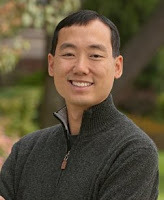 Andrew Lam, M.D., is the award-winning author of Repentance, Two Sons of China, and Saving Sight. His writing has appeared in The New York Times and The Washington Post. Born in Philadelphia and raised in central Illinois, he graduated summa cum laude in history from Yale University, where he studied military history and U.S.-East Asian relations. He then attended medical school at the University of Pennsylvania, followed by specialty training to become a retinal surgeon. He is an Assistant Professor at the University of Massachusetts Medical School and resides in western Massachusetts with his wife and four children.His newest book is Repentance, a historical novel and riveting family drama entwined with the history of the 442nd Regimental Combat Team, a group of Japanese American soldiers who fought valiantly in Europe during WWII while many of their families were incarcerated in camps like Manzanar at home. The 442nd became the most decorated unit in U.S. military history.Learn more at Andrew Lam’s website. You can also follow him on Facebook, Twitter, and Goodreads.
Andrew Lam, M.D., is the award-winning author of Repentance, Two Sons of China, and Saving Sight. His writing has appeared in The New York Times and The Washington Post. Born in Philadelphia and raised in central Illinois, he graduated summa cum laude in history from Yale University, where he studied military history and U.S.-East Asian relations. He then attended medical school at the University of Pennsylvania, followed by specialty training to become a retinal surgeon. He is an Assistant Professor at the University of Massachusetts Medical School and resides in western Massachusetts with his wife and four children.His newest book is Repentance, a historical novel and riveting family drama entwined with the history of the 442nd Regimental Combat Team, a group of Japanese American soldiers who fought valiantly in Europe during WWII while many of their families were incarcerated in camps like Manzanar at home. The 442nd became the most decorated unit in U.S. military history.Learn more at Andrew Lam’s website. You can also follow him on Facebook, Twitter, and Goodreads.

<!-- /* Font Definitions */ @font-face {font-family:"Cambria Math"; panose-1:2 4 5 3 5 4 6 3 2 4; mso-font-charset:0; mso-generic-font-family:roman; mso-font-pitch:variable; mso-font-signature:-536870145 1107305727 0 0 415 0;} @font-face {font-family:Calibri; panose-1:2 15 5 2 2 2 4 3 2 4; mso-font-charset:0; mso-generic-font-family:swiss; mso-font-pitch:variable; mso-font-signature:-1610611985 1073750139 0 0 159 0;} /* Style Definitions */ p.MsoNormal, li.MsoNormal, div.MsoNormal {mso-style-unhide:no; mso-style-qformat:yes; mso-style-parent:""; margin:0cm; margin-bottom:.0001pt; mso-pagination:widow-orphan; font-size:12.0pt; font-family:"Calibri",sans-serif; mso-ascii-font-family:Calibri; mso-ascii-theme-font:minor-latin; mso-fareast-font-family:Calibri; mso-fareast-theme-font:minor-latin; mso-hansi-font-family:Calibri; mso-hansi-theme-font:minor-latin; mso-bidi-font-family:"Times New Roman"; mso-bidi-theme-font:minor-bidi;} .MsoChpDefault {mso-style-type:export-only; mso-default-props:yes; font-family:"Calibri",sans-serif; mso-ascii-font-family:Calibri; mso-ascii-theme-font:minor-latin; mso-fareast-font-family:Calibri; mso-fareast-theme-font:minor-latin; mso-hansi-font-family:Calibri; mso-hansi-theme-font:minor-latin; mso-bidi-font-family:"Times New Roman"; mso-bidi-theme-font:minor-bidi;} @page WordSection1 {size:612.0pt 792.0pt; margin:72.0pt 72.0pt 72.0pt 72.0pt; mso-header-margin:36.0pt; mso-footer-margin:36.0pt; mso-paper-source:0;} div.WordSection1 {page:WordSection1;} </style> -->
Excerpt
“Chest full of blood,” Daniel muttered. “Rib spreader.”
Niraj handed him a large metal retractor, shaped like a C-clamp. Daniel placed the blades between the ribs and turned the crank to draw them apart.
“Suction.”
Niraj placed a plastic handpiece into the chest cavity. As the space between the ribs widened, Daniel pushed the collapsed left lung aside to expose the pericardium.
It was bulging, tense, and dark.
“Scissors.”
Sam Griffin stared, wide-eyed.
“It’s tamponade,” Daniel explained. He cut a small hole in the pericardium. There was a gush of blood.
Daniel felt the heart pulsing beneath his hand. On the monitor, the EKG line jumped jaggedly.
“More suction.” He enlarged the opening in the pericardium and began to inspect the heart. Blood flowed more briskly now.
Where was it coming from?
He used his fingers to gently feel the front and back of the heart. Then—he saw it and felt it at the same time.
There was a small hole at the edge of the right ventricle.
Was part of the bullet inside the heart or had it passed all the way through? Daniel stuck his finger through the hole and felt inside the pulsing chamber.
Nothing.
He gently lifted the heart and turned it slightly.
“More suction.”
No exit wound in the back.
He returned the heart to its normal position. It was a tangential wound. The bullet had grazed the heart then gone out the patient’s back.
“We’ve got to plug this hole to stop the bleeding.”
“Can you suture it?” Griffin asked, incredulous.
Daniel ignored him. “Get a foley.”
“What?” the nurse said.
“A foley, dammit! You know, foley catheter—you stick it in so people can pee. Hurry up.”
She ran into the hall and returned moments later with a thin rubber tube. The foley catheter had a double lumen—when inflated, the outer space at the tip of the catheter became a small balloon that normally kept the tube inside a patient’s bladder and prevented it from sliding out.
Daniel threaded the catheter through the hole in the heart. “Inflate it,” he said. Niraj gently depressed the plunger of a small syringe to fill the balloon inside the heart with saline. Through the heart wall, Daniel felt the tip of the tubing inflate.
“Stop.”
Now the small balloon in the right ventricle was the size of a marble. Blood flow inside the heart pushed the balloon against the hole, plugging it.
Daniel watched the monitor. The EKG line jerked up and down irregularly.
“Ventricular fibrillation. Give me the internal paddles and charge to 20 joules.”
A nurse handed him two small metal paddles, which Daniel placed on the front and back of the heart.
“Clear.” Daniel shocked the heart, which froze momentarily, then began to beat regularly.
The EKG returned to normal sinus rhythm.
“There’s a pulse!” the nurse called out. The next blood pressure reading came on the screen: 90/45. Better.
A little cheer went up among the others in the room.
Daniel looked at Niraj. “We’ve bought him some time. Keep a close eye on the foley. If you need to, just keep a little tension on it like this,” Daniel demonstrated, “to make sure the balloon stays against the hole. Continue wide open fluids. Start transfusing; as soon as the first unit is hung I want the second unit spiked and ready to infuse. And get him up to the OR. I’ll see you there in fifteen minutes.”
“You got it,” Niraj said, awestruck. His boss had just brought a kid back from the dead.
GiveawayDuring the Blog Tour, we will be giving away a paperback copy of Repentance by Andrew Lam! You can enter HERE!Giveaway Rules• Giveaway ends at 11:59 pm EST on May 31st. You must be 18 or older to enter.
• Giveaway is open INTERNATIONALLY.
• Only one entry per household.
• All giveaway entrants agree to be honest and not cheat the systems; any suspicion of fraud is decided upon by blog/site owner and the sponsor, and entrants may be disqualified at our discretion.
• The winner has 48 hours to claim prize or new winner is chosen.
Pick up your copy of Repentance
AMAZON • BARNES AND NOBLE • INDIEBOUND
Andrew Lam
 Andrew Lam, M.D., is the award-winning author of Repentance, Two Sons of China, and Saving Sight. His writing has appeared in The New York Times and The Washington Post. Born in Philadelphia and raised in central Illinois, he graduated summa cum laude in history from Yale University, where he studied military history and U.S.-East Asian relations. He then attended medical school at the University of Pennsylvania, followed by specialty training to become a retinal surgeon. He is an Assistant Professor at the University of Massachusetts Medical School and resides in western Massachusetts with his wife and four children.His newest book is Repentance, a historical novel and riveting family drama entwined with the history of the 442nd Regimental Combat Team, a group of Japanese American soldiers who fought valiantly in Europe during WWII while many of their families were incarcerated in camps like Manzanar at home. The 442nd became the most decorated unit in U.S. military history.Learn more at Andrew Lam’s website. You can also follow him on Facebook, Twitter, and Goodreads.
Andrew Lam, M.D., is the award-winning author of Repentance, Two Sons of China, and Saving Sight. His writing has appeared in The New York Times and The Washington Post. Born in Philadelphia and raised in central Illinois, he graduated summa cum laude in history from Yale University, where he studied military history and U.S.-East Asian relations. He then attended medical school at the University of Pennsylvania, followed by specialty training to become a retinal surgeon. He is an Assistant Professor at the University of Massachusetts Medical School and resides in western Massachusetts with his wife and four children.His newest book is Repentance, a historical novel and riveting family drama entwined with the history of the 442nd Regimental Combat Team, a group of Japanese American soldiers who fought valiantly in Europe during WWII while many of their families were incarcerated in camps like Manzanar at home. The 442nd became the most decorated unit in U.S. military history.Learn more at Andrew Lam’s website. You can also follow him on Facebook, Twitter, and Goodreads.
<!-- /* Font Definitions */ @font-face {font-family:"Cambria Math"; panose-1:2 4 5 3 5 4 6 3 2 4; mso-font-charset:0; mso-generic-font-family:roman; mso-font-pitch:variable; mso-font-signature:-536870145 1107305727 0 0 415 0;} @font-face {font-family:Calibri; panose-1:2 15 5 2 2 2 4 3 2 4; mso-font-charset:0; mso-generic-font-family:swiss; mso-font-pitch:variable; mso-font-signature:-1610611985 1073750139 0 0 159 0;} /* Style Definitions */ p.MsoNormal, li.MsoNormal, div.MsoNormal {mso-style-unhide:no; mso-style-qformat:yes; mso-style-parent:""; margin:0cm; margin-bottom:.0001pt; mso-pagination:widow-orphan; font-size:12.0pt; font-family:"Calibri",sans-serif; mso-ascii-font-family:Calibri; mso-ascii-theme-font:minor-latin; mso-fareast-font-family:Calibri; mso-fareast-theme-font:minor-latin; mso-hansi-font-family:Calibri; mso-hansi-theme-font:minor-latin; mso-bidi-font-family:"Times New Roman"; mso-bidi-theme-font:minor-bidi;} .MsoChpDefault {mso-style-type:export-only; mso-default-props:yes; font-family:"Calibri",sans-serif; mso-ascii-font-family:Calibri; mso-ascii-theme-font:minor-latin; mso-fareast-font-family:Calibri; mso-fareast-theme-font:minor-latin; mso-hansi-font-family:Calibri; mso-hansi-theme-font:minor-latin; mso-bidi-font-family:"Times New Roman"; mso-bidi-theme-font:minor-bidi;} @page WordSection1 {size:612.0pt 792.0pt; margin:72.0pt 72.0pt 72.0pt 72.0pt; mso-header-margin:36.0pt; mso-footer-margin:36.0pt; mso-paper-source:0;} div.WordSection1 {page:WordSection1;} </style> -->
Published on May 13, 2019 22:30
Celebrating 35 years of Robin of Sherwood: Interview with Daniel Rendell from Silver Arrow Tours #RobinofSherwood
Nothing’s forgotten. Nothing is ever forgotten.Celebrating 35 years of Robin of Sherwood.
Exclusive Interview with Daniel Rendell Uber-Fan, Admin, Convention organiser, Location finder, Prop collector. Plus, Archaeologist!
Memories of Robin of Sherwood.

Hi Daniel, welcome to Myths, Legends, Books & Coffee Pots…. It is so exciting that you could join us here today to talk about your memories of Robin of Sherwood.
As the co-admin of the very popular Robin of Sherwood Facebook Group and the organiser of the Silver Arrow Conventions, Robin of Sherwood has certainly influenced your life. What was it that first appealed to you about the show?
I’d grown up watching old black and white swashbuckler movies, and loved pirates, and any period film with swords. A favourite was always Scaramouche. I’d grown up in West Somerset, not far from some ros locations, and were greatly influenced by local legends, folklore, and sites connected to King Arthur. I hadn’t been a huge Robin Hood fan in truth, but RoS was different. I think it showed that the outlaws had a higher purpose, were fiercely loyal to one another even ‘til death, and that they were battling to preserve a way of life. Later I realised that it was the idea of the ‘man outside of the law’ that was a draw. Someone living off their wits, righting wrongs, and defending the down-trodden. I was quite a quiet child but with a strong moral centre so I loved Robin’s conviction and charisma, and that he wasn’t a textbook, square jawed, perfect hero. He had rough edges and an otherworldly mystery.
The Pre-Raphaelite beauty of the show in how the characters looked, and how the scenes were shot - how the mist curled around the trees, and light, shadow and smoke were all used to create mood really interested me later.
It is said that you are a ‘fountain of knowledge’ when it comes to Robin of Sherwood, what is your favourite episode and why?
My favourite is the first two years, but I have to say the second series is where RoS was at for me and represented the show at its peak. I adore the look of The Lord of the Trees, when the village set moved from Mells Estate to the centre of Bristol, in the valley alongside the River Frome. It felt wonderfully idyllic. I’d always been curious as to where exactly it had been filmed and was the first fan to revisit the location a few years back and work out where all the huts had been positioned.
The Swords of Wayland however had a filmatic quality to it, made for the big screen, and I think is the one episode that stands the test of time. It had danger, mystery, stunning big budget locations, and fed upon some very interesting mythical ideas and symbolism which ran into the last episode that year, The Greatest Enemy.
As for being a “fountain of knowledge.” I probably am borderline Asperger’s, so it means that anything I am interested in I really have to know everything about. I always found I had a good memory for detail or minutia. You collect Robin of Sherwood memorabilia. What is your most prized collection piece?
I was very lucky a number of years ago to cross paths with someone who worked as a student in the HTV design department, who did work on all three years of the production. At the end of the show a lot of things were thrown away by the production company. This was all before the prop industry was a thing per se. Now people would kill to own a piece of production history and such things tend to be preserved more, especially if they are cult films or shows. He could not bear to see items destroyed, so rescued a lot of items from the skip. They sat in his loft for many years but seeing my fascination and enthusiasm for the show, it took no persuasion at all to part with them. I had always maintained that ros was a collaborative production, where the crew were just as important as the cast. Being able to read all the scripts that had been used on location, and see the amount of effort that went into producing an hours worth of tv gave me a renewed respect for people who work in the industry who don’t are sometimes not given the same respect as actors who star in the productions.
Last year I was privileged to get the chance to be the first fan to view many of the principal artists costumes which, unknown to many, had been sold off by HTV to a theatrical costume supplier in Wales. I came to be the owner of one of the main costumes Michael Praed’s wore, and a few other bits of pieces. Robert Addie’s armour is an astonishing, and completely practical piece that could effectively still be worn as a suit of armour into battle today. It is immensely heavy, weighing around 7kg, and it certainly gives me sympathy for Robert who was forced to wear it, and even ride with it on. It’s impossible to put on without help.
But aside from the physical props and costumes, it’s probably the paperwork that gives me the most pleasure as it’s wonderful to pour over the call sheets, set plans, and production drawings of a winter’s night, as it adds another layer of appreciation of the show seeing how much hard work went in behind the cameras lens. All the sets were meticulously drawn out to scale onto architect’s paper, so that the production designers could make the steps, balconies & huts, in order to bring the episodes to life.
You were a big part of Silver Arrow Conventions. How did this come about?
Quite by accident. I had previously attended Albion 95 and 96, and gotten to know Janet, my future partner, and her friend Julie. Janet was running the UK fan club at the time and was responsible pretty much for championing the show in the UK, and creating a thriving European fandom that we come to take for granted today. It was after the first Silver Arrow that a few of the committee members dropped off, so it required more people to help organise future events. This was all pre-internet of course, so organisation took place a good year before, writing to guests, making leaflets and distributing around re-enactment events, new age shops, and just about anywhere you could leave a leaflet, trying to raise interest and awareness for the show and fandom. We wanted to host them in Bristol, being the “birthplace” of RoS, which would allow us a good base to host a location trip to some of the major filming locations on the second day. This we believed would make the conventions a little more memorable for fans than just sitting in a hotel room for two days watching video tapes.


Silver Arrow offered Robin of Sherwood location trips. Were you surprised by how popular these trips were? What was your most memorable location trip?
I’ve always maintained that getting out broadens your horizons, and that it gives you a new perspective on the show if you’re actually in the same spot as the actors were. The locations were one of the major attractions of the show. The forest could be seen as ‘the star’ in effect. Blaise Castle Estate has this effect on you. It’s a dense ‘jungle’ which strikes me as being what a medieval forest should look like. It also has several quite distinguishable ros features, like Goram’s Chair, which is a promontory which overlooks the valley below. This is where you get that wonderful pack-shot of Robin of Loxley looking out over his kingdom, and whilst doing his epic monologue at the end of the first double episode. For me though, Wells Cathedral holds some wry amusement. That year I had been made to dress as Robin, so found myself walking through Wells Cathedral, dressed as Michael, carrying an unsheathed sword, something I doubt you could get away with now. Rounding the corner to the famous stairs that lead to the Chapter House, I was quite unprepared for the number of cameras that were being whipped out to take photos of me running up and down the stairs, with sword in hand. I think I made it on to the HTV news that night too. It gave me a sense of what it might have been like to be on a film set for the cast, and certainly made me realise Michael’s pain to have to run up those hard, stone steps, and then pose for photos to please ‘my public!’
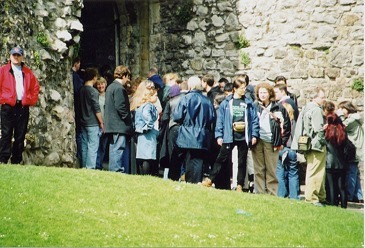
You are now the co-administrator of the Robin of Sherwood fan page over on Facebook, and to date, it has over 4,000 members. Are you surprised that 35 years after the show first aired that there is still such an interest in all things Robin of Sherwood?
Not at all. Quality always lasts. Ros is still as relevant as ever. Robin Hood is an international symbol and every country around the world has a figure back in history who was a ‘Robin Hood’ for them. It’s the idea that will never die. We get daily requests to join the group from people all over the globe. The group attracts a lot of intelligent, well-reasoned debate on all aspects of the series, its cast, and associated topics such as medieval history, to costume making, and film production. I have always tried to inject a sense of humour and sense of fun for the group. You cannot be serious all of the time. Being fans sometimes you tend to only see things from one perspective, so I like to play Devil’s Advocate from time to time to question well established opinions, and to look critically at things to see what could have been improved had there been more time. Ros wasn’t totally a perfect package all of the time, but by appreciating the problems with being a fast-paced tv production and how they often had to make sacrifices, it makes you realise how special it was, and why it is still held up as being one of the landmark drama series of the past 50 years.
Thank you for stopping by and talking to us today, Daniel.
If you would like to join the Robin of Sherwood fan page over on Facebook, you can do so HERE!
Published on May 13, 2019 21:30
May 12, 2019
Join me in conversation with Historical Fiction author, Christine Trent #HistoricalFiction #HFVBTBlogTours @crookedlanebks @hfvbt
Historical Fiction Virtual Blog Tours Presents...
A Murderous MaladyBy Christine Trent

For fans of Charles Todd and Deanna Raybourn comes Christine Trent’s second Florence Nightingale mystery.
Cholera has broken out in London, but Florence Nightingale has bigger problems when people begin dying of a far more intentional cause—murder.
The London summer of 1854 is drawing to a close when a deadly outbreak of cholera grips the city. Florence Nightingale is back on the scene marshaling her nurses to help treat countless suffering patients at Middlesex Hospital as the disease tears through the Soho slums. But beyond the dangers of the disease, something even more evil is seeping through the ailing streets of London.It begins with an attack on the carriage of Florence’s friend, Elizabeth Herbert, wife to Secretary at War Sidney Herbert. Florence survives, but her coachman does not. Within hours, Sidney’s valet stumbles into the hospital, mutters a few cryptic words about the attack, and promptly dies from cholera. Frantic that an assassin is stalking his wife, Sidney enlists Florence’s help, who accepts but has little to go on save for the valet’s last words and a curious set of dice in his jacket pocket. Soon, the suspects are piling up faster than cholera victims, as there seems to be no end to the number of people who bear a grudge against the Herbert household.Now, Florence is in a race against time—not only to save the victims of a lethal disease, but to foil a murderer with a disturbingly sinister goal—in A Murderous Malady.
A conversation with Christine Trent
Hi Christine, welcome to Myths, Legends, Books &Coffee Pots. Before we begin, please tell my readers who you are and why you do!
Hi! I’m Christine Trent, author of 11 novels and 2 novellas, including the Lady of Ashes mysteries and the Florence Nightingale mysteries. A MURDEROUS MALADY is the second book in the Florence Nightingale series. I collect books, dolls, fountain pens, and—much to my husband’s chagrin—cats. I love those little balls of fur! You can get more information about me at www.ChristineTrent.com.
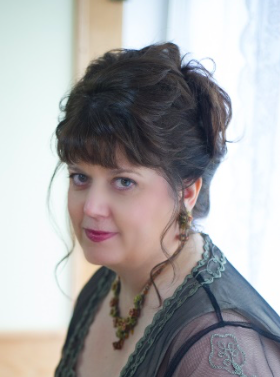
Your book, A Murderous Malady, looks fabulous. What inspired you to write it?I was in the middle of the Lady of Ashes mystery series about a Victorian undertaker when my agent asked me to think about a new mystery series, something still Victorian but a different take on the era. My mother had been a nurse for many years and even into retirement had held on to her nursing license. She was very proud of having earned it. It occurred to me that Florence Nightingale was a Victorian figure, and it would have been homage to my mother to write about the great nursing reformer.Plus, a nurse is going to encounter a lot of suspicious deaths, right?My mother was very excited about the idea, as was my agent, who got right to work on it. Unfortunately, mom had a serious medical condition and died before my agent sold the series to my wonderful editor at Crooked Lane Books.I like to think that mom would have been very happy about it. I wish she could have known.
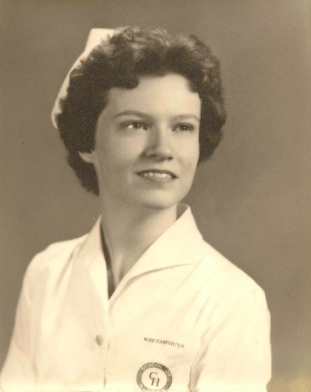
Christine’s mother in her nursing school photo.
Wow! Such inspirations. What were the challenges you faced in researching this period of history?
The 19th century was a whirlwind of change in Great Britain. If you were born in 1837, the year Queen Victoria ascended the throne, there was no part of your life that wasn’t completely different by the time of her death in 1901.You were born by candlelight, but by the end of your life you had gas lamps, and even electricity was starting to make its way into some areas.You traveled by horse and carriage in 1837, but by 1901, you not only had a network of trains to use, but you could even sail across the ocean by steamship in under a week.In 1837, surgery was a death sentence. By the turn of the 20th century, there existed a whole host of medicine, surgical practices, and hospital care that made your odds of survival pretty good.
Because of all these rapid changes, it can make it difficult to ensure that I’m getting everything right on a year-by-year basis. The series starts in 1853 and will run through at least the end of the Crimean War in 1856. Keeping up with societal and technological changes in just that 3-year period can be challenging.
It was certainly a time of rapid change. There are many books about the Victorian Age. Can you tell us three things that set your novels apart?
I enjoy writing about women in unusual professions, thus all of my books tend to be a bit different. I’ve written about a doll maker, a waxworker, a cloth merchant, and undertaker, and now I’ve taken on the great nursing reformer, Florence Nightingale. I would say my Florence Nightingale series in particular is unusual from many other Victorian novels in these 3 ways:
A focus on the middle class. Although Florence herself came from a wealthy background, she primarily served the poor and the emerging middle class. The series looks more closely at life and medicine for those Britons in the middle of society, rather than focusing on those on the lowest rungs (think workhouses) or the upper echelons of society (Mayfair).
No sugarcoating. Florence Nightingale is rightfully revered for single-handedly changing everything that ever existed about nursing and hospitals. She loved her patients and they adored her right back. But she could also be nervous, irritable, and waspish when things were not going her way. And although she was remarkably forward-thinking, she certainly had some views that might seem to be odd today. I try to portray Florence as she was, in both her glory and her flaws. It is my hope that readers enjoy the layered approach.
Fish Pie, Pickled Oysters, and Broxy. Characters in my books don’t just sit down to supper, they invite the reader in to share it with them. I use cookbooks of the time to ensure that meals are exactly the sort that that character would have had at the time. I even make sure that anyone’s name I use—first and last—was in use in the time period. I still manage to get details wrong, but I do try to get everything as accurate as possible.For those who are wondering, “Broxy” was a butcher’s term for any kind of meat—usually sheep—that had died of disease. Yes, there was a market for this meat in poor families. I’m guessing that people suffering from ingesting it would have kept Florence quite busy in the hospital!
 Too cute to ever be Broxy!
Too cute to ever be Broxy!Fabulous! What are you currently working on?
Well, my agent is shopping a new project and I don’t want to jinx it by saying too much about it. Let’s just say that it is both historical and modern, plus there is a lovable Chesapeake Bay Retriever as well as a creepy old house in it.
I’m also completing work on an anthology with Susanna Kearsley, C.S. Harris, and Anna Lee Huber. Featuring a cursed pocket watch’s travels through the centuries, Sourcebooks will be publishing THE DEADLY HOURS sometime in 2020.
Finally, I’m also quite busy on the board of the Historical Novel Society’s North American Conference, coming up June 20-22, 2019, at the Gaylord National Harbor Resort and Convention Center. Your readers might like to know that on June 22, we will have a Readers Festival where the public can mingle with their favorite historical authors, who in a variety of sub-genres (mystery, romance, military fiction, etc.). There will also be a huge book signing of 100+ authors. Book store available on site. Only $10 to attend, $5 advance purchase. Find out more HERE!
Thank you for dropping by and talking to us today!
Pick up your copy ofA Murderous MaladyAMAZON BARNES AND NOBLE BOOKS-A-MILLION INDIEBOUND
Christine Trent
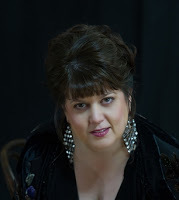 Christine Trent is the author of the Florence Nightingale Mysteries, the Lady of Ashes historical mystery series, about a Victorian-era undertaker, and three other historical novels. Christine’s novels have been translated into Turkish, Polish, and Czech. She writes from her two-story home library, where she lives with her husband, four precocious cats, a large doll collection, entirely too many fountain pens, and over 4,000 catalogued books.Learn more about Christine at www.christinetrent.com. You can also follow her on Facebook and Goodreads.
Christine Trent is the author of the Florence Nightingale Mysteries, the Lady of Ashes historical mystery series, about a Victorian-era undertaker, and three other historical novels. Christine’s novels have been translated into Turkish, Polish, and Czech. She writes from her two-story home library, where she lives with her husband, four precocious cats, a large doll collection, entirely too many fountain pens, and over 4,000 catalogued books.Learn more about Christine at www.christinetrent.com. You can also follow her on Facebook and Goodreads.
Published on May 12, 2019 23:00
May 11, 2019
Celebrating 35 years of Robin of Sherwood: Exclusive Guest Interview — Mark Ryan. #RobinOfSherwood @markryan243
Nothing’s forgotten. Nothing is ever forgotten.
Celebrating 35 years of Robin of Sherwood.
Exclusive Guest Interview Mark Ryan
 Nasir, played by Mark Ryan. Robin of Sherwood Series 3 Herne's Son Part 2.
Nasir, played by Mark Ryan. Robin of Sherwood Series 3 Herne's Son Part 2.
Outlaws. Misfits. Friends. The story of Robin Hood brought us some truly memorable characters. These stories have been passed down through the generations. They had been taken from the pages of whispered stories that perhaps was once told by travelling bards. In the 1980s this story was to take a new and fabulous twist. Richard Carpenter took something very old and breathed new life into the account. Not only did he do this, but he also added a uniquely wonderful new character into the story. I am of course talking about the Saracen, Nasir.
Today it is with the greatest of pleasure that I welcome actor, author, swordsman, fight director and voice actor, Mark Ryan, to the blog.
Hi Mark, welcome to Myths, Legends Books & Coffee Pots. I have been so looking forward to talking to you about Robin of Sherwood and the iconic role that you played in the series. So, without further ado, let’s begin!
Growing up in Doncaster, how aware were you as a child of the Robin Hood legend?
Well, I grew up in the middle of it. Sunday afternoons, during the summer, were spent in Clumber Park, wherein resides The Major Oak. As a child, we grew up playing Robin Hood, and back then we used to hide in The Major Oak, of course, you can't do that now. I actually have photographs of my mother, my aunty and my grandmother all standing in front of The Major Oak, so it wasn't just me who grew up playing in Sherwood Forest, but my family did as well. We also went to Scarborough, down to Robin Hood's Bay during the summer holidays.
But it wasn't just Robin Hood that we grew up with, down the road is Conisbrough Castle, the castle from Ivanhoe which was written by Sir Walter Scott. So, not only did we grow up with the legends of Robin Hood, but there was also Ivanhoe, King Arthur, and of course Celtic mythology — because Doncaster was a Celtic settlement before it was a Roman town. As a child, you just absorbed all of this history and legends in the natural daily interaction of life.
How did the role of Nasir come to your attention?
I was in the original cast of Evita in the West End. I initially played Magaldi, and then I cheekily asked if I could play Ché, which I did for another two years — which made four years in total. Ian Sharp came to see the show. He was doing a film at the time with Lewis Collins which I ended up being cast in called Who Dares Wins.
 Who Dares Wins: Lewis Collins, Ingrid Pitt and Mark.
Who Dares Wins: Lewis Collins, Ingrid Pitt and Mark.

After that film, I was talking to Ian about his next project, which so happened to be Robin of Sherwood. He said, "I may have a part for you in this. The character is called Edmund the Archer. There is not a lot of dialogue if, any dialogue at all. But, it is something I need a presence part for. Would you be interested?"
I said, "Of course, I would."
I found out they were shooting in Bamburgh Castle and Alnwick Castle, again places I knew — we had visited all of these locations on the Northumbrian coast as children. I then got a call to do some training with the boys, which we did at Steve Dent's farm.
On the first day of shooting at Alnwick Castle, Terry Watts and Ian came over. Terry was looking at me and looking at the swords, and he realised that I knew what I was doing with them. He showed me the swords he wanted me to use.
There are some pictures of me somewhere with these reverse swords, they were like Gurkha Kukri Knives, but they were three feet long — very unwieldy and dangerous to work with. I said, "Terry, these are dangerous. I can't control them."
He then said, "How about using two swords?"
I said, "Okay, not a problem. How long have I got?"
I think he said, "About two hours!"
So, as all actors do, I said, "Yeah, um, no problem."
"He said no, no. You have got about a week to rehearse! Also, how do you feel about not being Edmund the Archer but Nasir the Saracen instead?
I felt it was a bit of a jump from Edmund the Archer to a Saracen, but I said, "Alright!" So Edmund the Archer became Nasir the Saracen.
Paul Knight said to me, "You seem to be enjoying this, the lads all like you, did you want to stay with the show?"
I said, "I'd love to." Although I wasn't too sure how they were going to incorporate my character. Actually, it wasn't until the boys ran in after the sword fight with Michael — they were supposed to plant arrows in my back and save Michael — that they said, "No, no, we are not doing that today. We are not killing him."
Kip called me and said, "So, listen we have this Saracen character as part of the merry men, there is no dialogue per se but have you got any thoughts on what you would like to do with the character?" — This kind of thing would not happen today. You would not get a writer, a creator of a series calling an actor and asking if he had any ideas!

I said to Kip "I have just finished reading Steven Runciman's History of the Crusades, and I said in this series of books there is a well-detailed relationship between the Knights Templar and the Cult of the Assassins and the Old Man of the Mountains." I then explained what I had learnt.
Kip was fascinated by this, and he asked me if I would like him to put that in. To which, I said yes. "The only thing," Kip said, "Is that I have written the first two episodes and I have no dialogue for you, and I don't even know what dialogue to give you."
I said, "Kip, I don't care about the dialogue. It is television. It is a visual art. Give me the action. Give me the swords, the knife throwing, the archery, that tracking, the horse riding. Give me all of that stuff, and I will make it work, and I will speak through that. The character will present itself through the action."
So, that is how it came about.
I actually took some advice from Sir Anthony Hopkins. I was walking down through Soho, and I bumped into him, and I said, "You don't know me from Adam, but I just wanted to say you are the best screen actor of your generation. I have studied what you do (I was still doing Evita at the time). Sir Anthony talked to me for around 20 minutes about the difference between stage acting and screen acting. He gave me a piece of advice, which I used in Whose Dares Wins and Robin of Sherwood. He said, "Be still. Let the audience see into your mind. You don't need dialogue to do that. Be the character and let the audience decide what they make of you."
I didn't want Nasir to be a mindless killer. He had a sense of humour, a sense of honour and a sense of reverence for spirituality, even though it wasn't his spirituality. He understood that Herne the Hunter was seen as a spiritual character and he duly gave that character the respect it deserved. That was the little subtle elements I tried to bring into his character without using any dialogue.

I have spoken about Richard Carpenter a lot during this celebration and of course rightly so. But you also worked with some other fantastic writers as well, one of whom was Anthony Horowitz. I am sure many of my readers will recognise Anthony Horowitz because he is the author of the fabulous Alex Rider series. What was it like working with him?
Anthony Horowitz certainly had a tough act to follow.
Kip used to come out with us, go to dinner with us, go to the bars, and sit with us and chat with us. One night I remember asking him, "Kip, why are you here? What are you doing? What is going on?" and he said, "I am watching the way that you interact. The chemistry between you. I am going to write these characters the way you naturally interact with each other."
For Anthony Horowitz, coming into the show must have been a steep learning curve, but he got it, and he wrote some of the best episodes that we did.
In "The Sheriff of Nottingham" (Season 3 episode 6) your character Nasir comes face to face with his past, and it is seemingly the first time, despite everything that he has been through, where Nasir is not so sure of an outcome to a fight. Sarak, played by Valentine Pelka, was indeed a formidable opponent for Nasir, but what I would like to know is who was your favourite villain in the series and why?
Valentine Pelka and I are re-enacting that fight at The Hooded Man event on May 18th!
As for my favourite villain...
I thought Lewis Collins portrayal of Philip Mark was brilliant. I genuinely thought that they would not kill his character off. After all, you need really good bad guys. But as Paul said, "In every episode, the Sheriff of Nottingham escapes, Guy of Gisborne gets away. We have to kill somebody!"
But you really have to give "Best Villain" to Anthony Valentine for his portrayal of Baron Simon de Belleme. Belleme was fantastic. Anthony played him with this deadpan quiet stillness, and of course, the audience understood that there was something darkly menacing about him because of that stillness.
When Nasir had a sword in his hand, it sounds a little crazy, but it was kind of beautiful to watch. I can only think of one other actor who has pulled the same thing of as well as you and that was Mads Mikkelsen, who played Tristan in Antoine Fuqua's 2004 film King Arthur. I want to come away from Robin of Sherwood for a moment and talk about a few of the other things you have done since then. For those who don't know you were the Sword Master and Fight Director for King Arthur. The fight scenes in that movie are amazing; they so well choreographed — especially the battle at the end, which is so atmospheric. For many of us, we watch these fantastic movies and don't even think about the hours of work that goes into creating them. As an author, I have an idea of how I want a battle scene to go, but I don't have to get anyone to perform it physically. Where do you even begin? And how do you make less abled swordsman look like professionals?
 King Arthur, his Knights and Mark: (Left to Right) Sean Gilder, Pat Kinevane, Ray Winstone, Ioan Gruffudd, Mark Ryan, Joel Edgerton, Clive Owen, Mads Mikkelsen, Hugh Dancy, Ivano Marescotti and Ray Stevenson.
King Arthur, his Knights and Mark: (Left to Right) Sean Gilder, Pat Kinevane, Ray Winstone, Ioan Gruffudd, Mark Ryan, Joel Edgerton, Clive Owen, Mads Mikkelsen, Hugh Dancy, Ivano Marescotti and Ray Stevenson.
It is always a very complex endeavour when trying to put a battle scene together. You need a certain amount of knowledge and understanding to pull it off. Firstly, you need to work out how to get from A to B, and I do this by mapping out strategically with sketches and drawings.
In King Arthur, there is this huge battle scene at the end. I remember talking to Antoine Fuqua about the final battle. The plan was to dig a trench right across the middle of the battlefield and set it on fire. Well, I walked around the actual field and studied the land, and I saw a dry riverbed on the right-hand side of the field. I realised that we didn't need to dig a trench, we could use the riverbed. I suggested we set up what is called an L shaped ambush and let the land do the fighting for us. An L shaped ambush is when you draw half of the opposing army into the fight. The archers, who were led by Keira Knightley, would then set fire to the riverbed blocking their escape. Trapped, they can neither go back, because of the fire, but at the same time, they are facing a wall of arrows. The Knights can then attack the remainder of the army without the fear of being hit by the crossfire from their own side. And that is precisely what we did.
 Antoine Fuqua and Mark
Antoine Fuqua and Mark
 Mark with Keira Knightley.
Mark with Keira Knightley.
It is funny that you brought up Mads... When I assess someone's abilities with a sword, I get them to do a little sword kata. This gets them used to not only the power and the physical energy of the sword but also how it flows. When I saw Mads working out at Steve Dent's farm, just doing this kata, I was reminded of this old Celtic saying:
"Never give a sword to a man who can't dance."
I went to Mads, and I said, "I have a daft question for you — did you train as a dancer?"
He said, "Yeah, I did."
I said, "What did you do?"
He replied, "I trained for ballet, but I was too tall. How did you know I had trained as a dancer?"
I said, "Because I am watching the way that you move your body and you shift your weight. I am going to come up with something different for you which will be very stylish and artistic. I want it to appear that you intuitively know where the angle of attack is coming from before your opponent even knows. So, you are going to be able to parry and cut and then turn to the next guy even before he knows he is coming in." I wanted him to have this almost 360º feel, which is why the hawk was there, so it is almost as if he is looking at himself in an out-of-body experience.
 Mads Mikkelsen with the Japanese Yang-Ling blade.
Mads Mikkelsen with the Japanese Yang-Ling blade.
I had Mads' sword custom made as they wanted his sword to have a different look — it is actually a Japanese Yang-Ling blade. The blade was made for us by Tommy Dunn, who now works on Game of Thrones.
Mads character dies in the film, and I wanted to make his death as emotionally traumatic as possible. There is virtually no blood in the scene, no continuous violence. It is a simple fight, and when he is dying, he looks up and watches his spirit, in the form of this bird, fly away. Simple but very effective.
You also asked how I made less abled swordsman look like professionals. When I did First Knight, I worked with Bob Anderson. I heard Bob say once that a sword fight is a conversation in steel. It is not an action sequence; you are actually doing dialogue with somebody else. Stellan Skarsgård came to me and said, he had never done a fight on screen in his life. I told him about the Bob Anderson conversation I had, and I told him to trust me. Stellan trusted me to make it work, and I was very honoured that he did.
I have to ask you about Transformers. You are the voice of Bumblebee, Jetfire and Lockdown in the multi-million grossing Transformer series. How did the role of Bumblebee come about and what was it like working with the director, Michael Bay?
I’ve had ten years of ground breaking film making, working with some of the very best talent Hollywood has to offer, both on and off the screen and worked on the set of all 5 Transformer movies. It’s a test of fortitude and flexibility but also an honour to have worked with everybody from Frances McDormand, Shia LaBeouf, John Turturro and of course, Mark Walberg. I did the dialogue with all of them on the set, which was obviously a great experience, and various character voices survived into the finished films.
 On location, Alnwick Castle — Transformers 5: The Last Knight.
On location, Alnwick Castle — Transformers 5: The Last Knight.
It came about because they were looking for someone to do these voices on the set and work with the actors. They also wanted someone who could technically understand the movements of the camera and the action as well as do the voices of the robots.
In the original film, Bumblebee didn't speak, but once when we were working in Michael's offices in Santa Monica, he said, "Say these lines." So, I said those lines, not really knowing or understanding how they were going to be used in the film. I had not seen the entire script. I only saw the bits of dialogue that I was doing as a robot with Shia. They used the lines in the first film, so I am now forever associated with Bumblebee. I like to think there is a bit of my personality that shines through Bumblebee's character as well because he is always positive no matter what happens to him. He gets battered and broken up, but he still goes back for more!
 Mark with Michael Bay.
Mark with Michael Bay.
As for Michael, there is no doubt in my mind that he is a creative genius. He is in a class of his own. But don't take my word for it. While on set, Sir Anthony Hopkins said to me something along these lines,
"Michael really is a genius, isn't he? I have worked with a few directors, and I have never seen a director do what Michael can do. He can pick up any camera (of which there were half-a-dozen or more), he can pick up any lighting effects, he knows about stunts, he knows about editing, he knows how to work every piece of equipment on the set. He could probably do every job on this set..."
Michael is always 110% immersed in what is happening with the movie.
 Mark with Sir Anthony Hopkins .
Mark with Sir Anthony Hopkins .
As I said, I did the voice for the character robots on set. — Optimus Prime, Megatron, Bumblebee, everyone. I also played Lockdown and of course the glory of Jetfire. A couple of weeks of doing Jetfire's voice in the studio Michael asked me, "Who is that voice you are doing?" I said, "It is a mate of mine called Ray Winstone!"
When the film came out Ray rang me up, and he said, "Marky, you cheeky bugger, I've just seen the film – you nicked my voice. I have been all kinds of things in films, and now I am a giant alien robot – you owe me a beer!"
So, that is how my involvement with Transformers came about. It evolved on the set as it was shot.
You are also known for your interest in tarot, and you have your own tarot deck which readers can buy on Amazon. Where did your interest in tarot start and what prompted you to create your own tarot deck?
I bought my first tarot deck in Los Angeles — it must have 1981 — in a shop called The Bodhi Tree. I was actually looking at mythological books but came out with the deck. I didn't know anything about tarot, then. I had looked at runes before but they never really spoke to me, and neither did tarot. I think that was because a lot of tarot decks are based on Kabbalah and I don't speak Kabbalah, and Kabbalah does not speak to me. I did get hold of a Rider Waite deck which was a little more accessible even though it was still based on Kabbalah.
I came to understand that the Major Arcana Tarot is a map of the human psyche — there is no magic in the cards. The imagery is just different fractions of the types of personality that live in a person's head. So, for example, when you go to work you put on this character, sometimes when you go to the bar you put on that character, and so on. We have fractions of these different people which we put on in different situations. As an actor that is what I do for a living, anyway. I draw from an emotion to build a part and to play a character, so the Major Arcana Tarot didn't sound unusual to me.
What I couldn't get into was trying to understand the nature of synchronicity and why the reading of the cards and the placing of the cards seemed to work. I wanted to know why, how, they worked. That is why I studied quantum physics to try to understand the nature of how our consciousness interacts with the "greater consciousness" or the "universal consciousness."
To cut a long story short, after Robin of Sherwood, Chesca Potter asked me if I was interested in doing a Robin of Sherwood tarot, but I thought that although the archetypes were certainly there for a Robin of Sherwood tarot, it was a little limited. So, we started to explore the whole mythos of the Greenwood as the basis of a tarot deck.
We laid out a Rider Waite tarot deck on my floor, and we realised that the Wheel of the Year system was actually easier to navigate and more accessible than the Kabbalah system. We evolved the system together. We did a lot of research, including going to mythological places such as Avebury to try to tune in and understand what part of that related to the tarot mythos itself. It took almost four years to put it all together, but what made the Greenwood Tarot so ground-breaking was that it fitted naturally around the Wheel of the Year.
Back to Sherwood. All the actors that I have spoken to have said what a fantastic atmosphere it was like on set. Clive Mantle mentioned that Ray Winstone, who played Will Scarlet, was your social secretary and in charge of japes and wind-ups. What was the most memorable wind-up that you were involved with?
I just want to start by saying, this would never happen on a set today!
We had a young stuntman/horse master called Steve Dent, who is now one of the top stunt coordinators in the world, but back then he was just starting out, and he was very gung-ho and up for anything. So, Ian wrote in a scene where we catch a Norman soldier by his foot, and he is left hanging in a tree. Ian also gave Steve some dialogue. You ask any stuntman, and they will all say they are terrified of dialogue. Steve was no exception! Steve went to Terry Walsh and said he didn't want to do the dialogue. Terry told him that he had to as it was in the script!
Well, this went on for almost two months! Steve would be seen walking around the locations practising his lines, a look of concern upon his face.
The whole thing was set up to happen on Steve's birthday. We all gathered around for the stunt, and when he was hanging from the tree, they wheeled in a giant birthday cake, and that was when Steve realised he had been set-up!
We spent a lot of time shooting outtake set-ups by Ray or Nick. We probably shot enough outtakes to make an episode! Nick was a big one for setting up these jokes with Robert Addie, and that along with the atmosphere, the humour, and the camaraderie, made the show what it was.
Robin of Sherwood had a little bit of everything. It was a love story, as well as story of the deepest of friendships. There was the good vs the evil theme running through it as well. The difference between Christianity and the pagan religion was also documented and let's not forget the whole mystical feel of the story. Here we are 35 years on, and we are still talking about the show. Did you, have any idea just how popular Robin of Sherwood was going to be? And are you surprised that it has stood the test of time?
Clive and I did discuss this very early on in the first series. We realised there was something very special about what we were doing. Clive said something like, "We are the young lions, and what we do with this is going to echo throughout all of our careers. And for however long this goes on for we have to make the most of it."

I think it is fair to say, that we all felt that. I don't know if we knew the interest was going to last for 35 years when I look back now. I used to think there should have been a big battle, and we should all have died to bring finality to the characters' lives. But now I think it is more fitting that it is left open to people's imaginations.
Thank you so much Mark for the special insight into Robin of Sherwood, King Arthur, Transformers and the tarot.
*All images are copyright protected. Mark Ryan has kindly granted permission to use the said images for the purpose of this blog post only.
If you would like to find out more about Mark Ryan and his extraordinary
life, then pick up a copy of his biography:
Hold Fast: A Hollywood Pirate's Tale
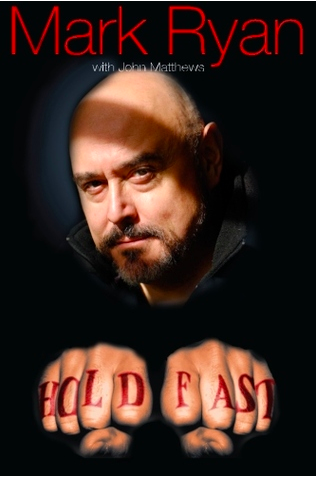
It would be virtually impossible to invent Mark Ryan. In his life he has been a secret soldier, a West End leading man, a cult TV icon, a Hollywood actor, a licensed private investigator and an advisor to the L.A. Police Department. He has written two books about the history and psychology of tarot, taught intelligence officers how to uncover secrets and actors how to use a sword, as well as working with some of the biggest names in Hollywood. Here, in collaboration with New York Times bestselling author John Matthews, a long time friend, Mark tells his amazing story.
Amazon UK • Amazon US
If you would like to learn more about The Wildwood Tarot:
Wild Magic The Wildwood Tarot Workbook
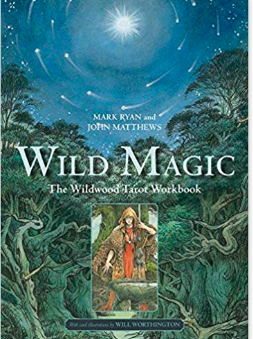
Want to delve deeper into the concepts that made The Wildwood Tarot wildly popular? This workbook further explores those powerful ancient traditions.
Wild Magic invokes the power of the Wildwood—the Green Man and Green Woman, as well as all the living archetypes of the forest, such as Herne the Hunter and Robin-i-the-Hood. Journey across time to the pre-Celtic world where primal forces, in the guise of animal, bird, and fish, roamed free and opened doorways into the otherworld of the Ancestors. With chapters on the Lore of the Wild, the Wheel of the Year, shamanic methods of examining the wild, and meditations designed to enable personal encounters with Wildwood archetypes, as well as newly crafted rituals enabling readers to celebrate festivals such as the Midsummer and Midwinter Solstices, the book takes a fresh and informed look at a set of ancient traditions applied to the present.
Amazon UK • Amazon US
Mark Ryan
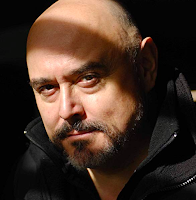
British born Mark has been combining his acting, singing, writing and action direction talents in an eclectic and successful international career ranging over 30 years.
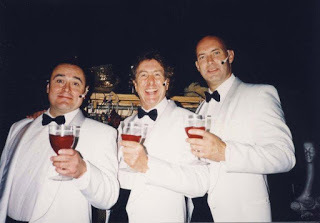 Touring with US Eric IdleMark performed in several major musicals in London's West End, spending four years in Andrew Lloyd Webber's smash hit Evita originating the role of Magaldi and then playing Ché under the direction of Broadway legend Hal Prince. He left Evita to play Mac in the classic SAS action film Who Dares Wins.
Touring with US Eric IdleMark performed in several major musicals in London's West End, spending four years in Andrew Lloyd Webber's smash hit Evita originating the role of Magaldi and then playing Ché under the direction of Broadway legend Hal Prince. He left Evita to play Mac in the classic SAS action film Who Dares Wins.
He originated the character of Nasir for the cult British TV series Robin of Sherwood on which he worked for three years, and has appeared in dozens of films and television series, both in the US and UK.
He won critical acclaim for the title role in the musical Elmer Gantry at London's Gate Theatre and followed that with a national tour of the hit show Guys and Dolls, playing Sky Masterson. He returned to the West End to play Neville Landless in the Tony Award-winning musical The Mystery of Edwin Drood and toured Europe playing Figaro and Leporello in Mozart's Figaro and Don Giovanni. He toured the US in Eric Idle Exploits Monty Python with original Python; Eric Idle, performing at Carnegie Hall and the Hollywood Bowl and is a published author with both the classic Greenwood Tarot and the bestselling Wildwood Tarot. His biography Hold Fast will be released in the US in Dec 2015.
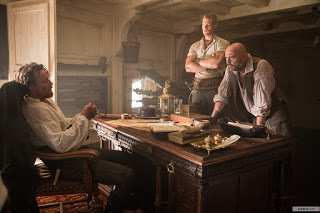 Mark has also worked with such acclaimed directors as Antoine Fuqua on King Arthur, JJ Abrams on the series Alias and Christopher Nolan in the feature The Prestige and he can be seen as Quartermaster Gates in Starz's most watched original series "Black Sails", produced by Michael Bay.
Mark has also worked with such acclaimed directors as Antoine Fuqua on King Arthur, JJ Abrams on the series Alias and Christopher Nolan in the feature The Prestige and he can be seen as Quartermaster Gates in Starz's most watched original series "Black Sails", produced by Michael Bay.
Mark has enjoyed working on all five of the hugely successful Transformers movies for legendary director Michael Bay as the on-set voice of the Autobots and voiced Bumblebee and Jetfire for the franchise. In 2013 Mark again joined the Transformers franchise, voicing Lockdown in the fourth instalment, Transformers: Age of Extinction. In 2014 the film broke worldwide records earning over $1.08 billion in box office receipts. Ryan was nominated in 2015 for the award for best vocal performance in a supporting role in a feature film by Behind The Voice Actors.
To learn more about Mark visit his official website, click HERE!
Celebrating 35 years of Robin of Sherwood.
Exclusive Guest Interview Mark Ryan
 Nasir, played by Mark Ryan. Robin of Sherwood Series 3 Herne's Son Part 2.
Nasir, played by Mark Ryan. Robin of Sherwood Series 3 Herne's Son Part 2.Outlaws. Misfits. Friends. The story of Robin Hood brought us some truly memorable characters. These stories have been passed down through the generations. They had been taken from the pages of whispered stories that perhaps was once told by travelling bards. In the 1980s this story was to take a new and fabulous twist. Richard Carpenter took something very old and breathed new life into the account. Not only did he do this, but he also added a uniquely wonderful new character into the story. I am of course talking about the Saracen, Nasir.
Today it is with the greatest of pleasure that I welcome actor, author, swordsman, fight director and voice actor, Mark Ryan, to the blog.
Hi Mark, welcome to Myths, Legends Books & Coffee Pots. I have been so looking forward to talking to you about Robin of Sherwood and the iconic role that you played in the series. So, without further ado, let’s begin!
Growing up in Doncaster, how aware were you as a child of the Robin Hood legend?
Well, I grew up in the middle of it. Sunday afternoons, during the summer, were spent in Clumber Park, wherein resides The Major Oak. As a child, we grew up playing Robin Hood, and back then we used to hide in The Major Oak, of course, you can't do that now. I actually have photographs of my mother, my aunty and my grandmother all standing in front of The Major Oak, so it wasn't just me who grew up playing in Sherwood Forest, but my family did as well. We also went to Scarborough, down to Robin Hood's Bay during the summer holidays.
But it wasn't just Robin Hood that we grew up with, down the road is Conisbrough Castle, the castle from Ivanhoe which was written by Sir Walter Scott. So, not only did we grow up with the legends of Robin Hood, but there was also Ivanhoe, King Arthur, and of course Celtic mythology — because Doncaster was a Celtic settlement before it was a Roman town. As a child, you just absorbed all of this history and legends in the natural daily interaction of life.
How did the role of Nasir come to your attention?
I was in the original cast of Evita in the West End. I initially played Magaldi, and then I cheekily asked if I could play Ché, which I did for another two years — which made four years in total. Ian Sharp came to see the show. He was doing a film at the time with Lewis Collins which I ended up being cast in called Who Dares Wins.
 Who Dares Wins: Lewis Collins, Ingrid Pitt and Mark.
Who Dares Wins: Lewis Collins, Ingrid Pitt and Mark.
After that film, I was talking to Ian about his next project, which so happened to be Robin of Sherwood. He said, "I may have a part for you in this. The character is called Edmund the Archer. There is not a lot of dialogue if, any dialogue at all. But, it is something I need a presence part for. Would you be interested?"
I said, "Of course, I would."
I found out they were shooting in Bamburgh Castle and Alnwick Castle, again places I knew — we had visited all of these locations on the Northumbrian coast as children. I then got a call to do some training with the boys, which we did at Steve Dent's farm.
On the first day of shooting at Alnwick Castle, Terry Watts and Ian came over. Terry was looking at me and looking at the swords, and he realised that I knew what I was doing with them. He showed me the swords he wanted me to use.
There are some pictures of me somewhere with these reverse swords, they were like Gurkha Kukri Knives, but they were three feet long — very unwieldy and dangerous to work with. I said, "Terry, these are dangerous. I can't control them."
He then said, "How about using two swords?"
I said, "Okay, not a problem. How long have I got?"
I think he said, "About two hours!"
So, as all actors do, I said, "Yeah, um, no problem."
"He said no, no. You have got about a week to rehearse! Also, how do you feel about not being Edmund the Archer but Nasir the Saracen instead?
I felt it was a bit of a jump from Edmund the Archer to a Saracen, but I said, "Alright!" So Edmund the Archer became Nasir the Saracen.
Paul Knight said to me, "You seem to be enjoying this, the lads all like you, did you want to stay with the show?"
I said, "I'd love to." Although I wasn't too sure how they were going to incorporate my character. Actually, it wasn't until the boys ran in after the sword fight with Michael — they were supposed to plant arrows in my back and save Michael — that they said, "No, no, we are not doing that today. We are not killing him."
Kip called me and said, "So, listen we have this Saracen character as part of the merry men, there is no dialogue per se but have you got any thoughts on what you would like to do with the character?" — This kind of thing would not happen today. You would not get a writer, a creator of a series calling an actor and asking if he had any ideas!

I said to Kip "I have just finished reading Steven Runciman's History of the Crusades, and I said in this series of books there is a well-detailed relationship between the Knights Templar and the Cult of the Assassins and the Old Man of the Mountains." I then explained what I had learnt.
Kip was fascinated by this, and he asked me if I would like him to put that in. To which, I said yes. "The only thing," Kip said, "Is that I have written the first two episodes and I have no dialogue for you, and I don't even know what dialogue to give you."
I said, "Kip, I don't care about the dialogue. It is television. It is a visual art. Give me the action. Give me the swords, the knife throwing, the archery, that tracking, the horse riding. Give me all of that stuff, and I will make it work, and I will speak through that. The character will present itself through the action."
So, that is how it came about.
I actually took some advice from Sir Anthony Hopkins. I was walking down through Soho, and I bumped into him, and I said, "You don't know me from Adam, but I just wanted to say you are the best screen actor of your generation. I have studied what you do (I was still doing Evita at the time). Sir Anthony talked to me for around 20 minutes about the difference between stage acting and screen acting. He gave me a piece of advice, which I used in Whose Dares Wins and Robin of Sherwood. He said, "Be still. Let the audience see into your mind. You don't need dialogue to do that. Be the character and let the audience decide what they make of you."
I didn't want Nasir to be a mindless killer. He had a sense of humour, a sense of honour and a sense of reverence for spirituality, even though it wasn't his spirituality. He understood that Herne the Hunter was seen as a spiritual character and he duly gave that character the respect it deserved. That was the little subtle elements I tried to bring into his character without using any dialogue.

I have spoken about Richard Carpenter a lot during this celebration and of course rightly so. But you also worked with some other fantastic writers as well, one of whom was Anthony Horowitz. I am sure many of my readers will recognise Anthony Horowitz because he is the author of the fabulous Alex Rider series. What was it like working with him?
Anthony Horowitz certainly had a tough act to follow.
Kip used to come out with us, go to dinner with us, go to the bars, and sit with us and chat with us. One night I remember asking him, "Kip, why are you here? What are you doing? What is going on?" and he said, "I am watching the way that you interact. The chemistry between you. I am going to write these characters the way you naturally interact with each other."
For Anthony Horowitz, coming into the show must have been a steep learning curve, but he got it, and he wrote some of the best episodes that we did.
In "The Sheriff of Nottingham" (Season 3 episode 6) your character Nasir comes face to face with his past, and it is seemingly the first time, despite everything that he has been through, where Nasir is not so sure of an outcome to a fight. Sarak, played by Valentine Pelka, was indeed a formidable opponent for Nasir, but what I would like to know is who was your favourite villain in the series and why?
Valentine Pelka and I are re-enacting that fight at The Hooded Man event on May 18th!
As for my favourite villain...
I thought Lewis Collins portrayal of Philip Mark was brilliant. I genuinely thought that they would not kill his character off. After all, you need really good bad guys. But as Paul said, "In every episode, the Sheriff of Nottingham escapes, Guy of Gisborne gets away. We have to kill somebody!"
But you really have to give "Best Villain" to Anthony Valentine for his portrayal of Baron Simon de Belleme. Belleme was fantastic. Anthony played him with this deadpan quiet stillness, and of course, the audience understood that there was something darkly menacing about him because of that stillness.
When Nasir had a sword in his hand, it sounds a little crazy, but it was kind of beautiful to watch. I can only think of one other actor who has pulled the same thing of as well as you and that was Mads Mikkelsen, who played Tristan in Antoine Fuqua's 2004 film King Arthur. I want to come away from Robin of Sherwood for a moment and talk about a few of the other things you have done since then. For those who don't know you were the Sword Master and Fight Director for King Arthur. The fight scenes in that movie are amazing; they so well choreographed — especially the battle at the end, which is so atmospheric. For many of us, we watch these fantastic movies and don't even think about the hours of work that goes into creating them. As an author, I have an idea of how I want a battle scene to go, but I don't have to get anyone to perform it physically. Where do you even begin? And how do you make less abled swordsman look like professionals?
 King Arthur, his Knights and Mark: (Left to Right) Sean Gilder, Pat Kinevane, Ray Winstone, Ioan Gruffudd, Mark Ryan, Joel Edgerton, Clive Owen, Mads Mikkelsen, Hugh Dancy, Ivano Marescotti and Ray Stevenson.
King Arthur, his Knights and Mark: (Left to Right) Sean Gilder, Pat Kinevane, Ray Winstone, Ioan Gruffudd, Mark Ryan, Joel Edgerton, Clive Owen, Mads Mikkelsen, Hugh Dancy, Ivano Marescotti and Ray Stevenson.It is always a very complex endeavour when trying to put a battle scene together. You need a certain amount of knowledge and understanding to pull it off. Firstly, you need to work out how to get from A to B, and I do this by mapping out strategically with sketches and drawings.
In King Arthur, there is this huge battle scene at the end. I remember talking to Antoine Fuqua about the final battle. The plan was to dig a trench right across the middle of the battlefield and set it on fire. Well, I walked around the actual field and studied the land, and I saw a dry riverbed on the right-hand side of the field. I realised that we didn't need to dig a trench, we could use the riverbed. I suggested we set up what is called an L shaped ambush and let the land do the fighting for us. An L shaped ambush is when you draw half of the opposing army into the fight. The archers, who were led by Keira Knightley, would then set fire to the riverbed blocking their escape. Trapped, they can neither go back, because of the fire, but at the same time, they are facing a wall of arrows. The Knights can then attack the remainder of the army without the fear of being hit by the crossfire from their own side. And that is precisely what we did.
 Antoine Fuqua and Mark
Antoine Fuqua and Mark Mark with Keira Knightley.
Mark with Keira Knightley.It is funny that you brought up Mads... When I assess someone's abilities with a sword, I get them to do a little sword kata. This gets them used to not only the power and the physical energy of the sword but also how it flows. When I saw Mads working out at Steve Dent's farm, just doing this kata, I was reminded of this old Celtic saying:
"Never give a sword to a man who can't dance."
I went to Mads, and I said, "I have a daft question for you — did you train as a dancer?"
He said, "Yeah, I did."
I said, "What did you do?"
He replied, "I trained for ballet, but I was too tall. How did you know I had trained as a dancer?"
I said, "Because I am watching the way that you move your body and you shift your weight. I am going to come up with something different for you which will be very stylish and artistic. I want it to appear that you intuitively know where the angle of attack is coming from before your opponent even knows. So, you are going to be able to parry and cut and then turn to the next guy even before he knows he is coming in." I wanted him to have this almost 360º feel, which is why the hawk was there, so it is almost as if he is looking at himself in an out-of-body experience.
 Mads Mikkelsen with the Japanese Yang-Ling blade.
Mads Mikkelsen with the Japanese Yang-Ling blade.I had Mads' sword custom made as they wanted his sword to have a different look — it is actually a Japanese Yang-Ling blade. The blade was made for us by Tommy Dunn, who now works on Game of Thrones.
Mads character dies in the film, and I wanted to make his death as emotionally traumatic as possible. There is virtually no blood in the scene, no continuous violence. It is a simple fight, and when he is dying, he looks up and watches his spirit, in the form of this bird, fly away. Simple but very effective.
You also asked how I made less abled swordsman look like professionals. When I did First Knight, I worked with Bob Anderson. I heard Bob say once that a sword fight is a conversation in steel. It is not an action sequence; you are actually doing dialogue with somebody else. Stellan Skarsgård came to me and said, he had never done a fight on screen in his life. I told him about the Bob Anderson conversation I had, and I told him to trust me. Stellan trusted me to make it work, and I was very honoured that he did.
I have to ask you about Transformers. You are the voice of Bumblebee, Jetfire and Lockdown in the multi-million grossing Transformer series. How did the role of Bumblebee come about and what was it like working with the director, Michael Bay?
I’ve had ten years of ground breaking film making, working with some of the very best talent Hollywood has to offer, both on and off the screen and worked on the set of all 5 Transformer movies. It’s a test of fortitude and flexibility but also an honour to have worked with everybody from Frances McDormand, Shia LaBeouf, John Turturro and of course, Mark Walberg. I did the dialogue with all of them on the set, which was obviously a great experience, and various character voices survived into the finished films.
 On location, Alnwick Castle — Transformers 5: The Last Knight.
On location, Alnwick Castle — Transformers 5: The Last Knight.It came about because they were looking for someone to do these voices on the set and work with the actors. They also wanted someone who could technically understand the movements of the camera and the action as well as do the voices of the robots.
In the original film, Bumblebee didn't speak, but once when we were working in Michael's offices in Santa Monica, he said, "Say these lines." So, I said those lines, not really knowing or understanding how they were going to be used in the film. I had not seen the entire script. I only saw the bits of dialogue that I was doing as a robot with Shia. They used the lines in the first film, so I am now forever associated with Bumblebee. I like to think there is a bit of my personality that shines through Bumblebee's character as well because he is always positive no matter what happens to him. He gets battered and broken up, but he still goes back for more!
 Mark with Michael Bay.
Mark with Michael Bay.As for Michael, there is no doubt in my mind that he is a creative genius. He is in a class of his own. But don't take my word for it. While on set, Sir Anthony Hopkins said to me something along these lines,
"Michael really is a genius, isn't he? I have worked with a few directors, and I have never seen a director do what Michael can do. He can pick up any camera (of which there were half-a-dozen or more), he can pick up any lighting effects, he knows about stunts, he knows about editing, he knows how to work every piece of equipment on the set. He could probably do every job on this set..."
Michael is always 110% immersed in what is happening with the movie.
 Mark with Sir Anthony Hopkins .
Mark with Sir Anthony Hopkins .As I said, I did the voice for the character robots on set. — Optimus Prime, Megatron, Bumblebee, everyone. I also played Lockdown and of course the glory of Jetfire. A couple of weeks of doing Jetfire's voice in the studio Michael asked me, "Who is that voice you are doing?" I said, "It is a mate of mine called Ray Winstone!"
When the film came out Ray rang me up, and he said, "Marky, you cheeky bugger, I've just seen the film – you nicked my voice. I have been all kinds of things in films, and now I am a giant alien robot – you owe me a beer!"
So, that is how my involvement with Transformers came about. It evolved on the set as it was shot.
You are also known for your interest in tarot, and you have your own tarot deck which readers can buy on Amazon. Where did your interest in tarot start and what prompted you to create your own tarot deck?
I bought my first tarot deck in Los Angeles — it must have 1981 — in a shop called The Bodhi Tree. I was actually looking at mythological books but came out with the deck. I didn't know anything about tarot, then. I had looked at runes before but they never really spoke to me, and neither did tarot. I think that was because a lot of tarot decks are based on Kabbalah and I don't speak Kabbalah, and Kabbalah does not speak to me. I did get hold of a Rider Waite deck which was a little more accessible even though it was still based on Kabbalah.
I came to understand that the Major Arcana Tarot is a map of the human psyche — there is no magic in the cards. The imagery is just different fractions of the types of personality that live in a person's head. So, for example, when you go to work you put on this character, sometimes when you go to the bar you put on that character, and so on. We have fractions of these different people which we put on in different situations. As an actor that is what I do for a living, anyway. I draw from an emotion to build a part and to play a character, so the Major Arcana Tarot didn't sound unusual to me.
What I couldn't get into was trying to understand the nature of synchronicity and why the reading of the cards and the placing of the cards seemed to work. I wanted to know why, how, they worked. That is why I studied quantum physics to try to understand the nature of how our consciousness interacts with the "greater consciousness" or the "universal consciousness."
To cut a long story short, after Robin of Sherwood, Chesca Potter asked me if I was interested in doing a Robin of Sherwood tarot, but I thought that although the archetypes were certainly there for a Robin of Sherwood tarot, it was a little limited. So, we started to explore the whole mythos of the Greenwood as the basis of a tarot deck.
We laid out a Rider Waite tarot deck on my floor, and we realised that the Wheel of the Year system was actually easier to navigate and more accessible than the Kabbalah system. We evolved the system together. We did a lot of research, including going to mythological places such as Avebury to try to tune in and understand what part of that related to the tarot mythos itself. It took almost four years to put it all together, but what made the Greenwood Tarot so ground-breaking was that it fitted naturally around the Wheel of the Year.
Back to Sherwood. All the actors that I have spoken to have said what a fantastic atmosphere it was like on set. Clive Mantle mentioned that Ray Winstone, who played Will Scarlet, was your social secretary and in charge of japes and wind-ups. What was the most memorable wind-up that you were involved with?
I just want to start by saying, this would never happen on a set today!
We had a young stuntman/horse master called Steve Dent, who is now one of the top stunt coordinators in the world, but back then he was just starting out, and he was very gung-ho and up for anything. So, Ian wrote in a scene where we catch a Norman soldier by his foot, and he is left hanging in a tree. Ian also gave Steve some dialogue. You ask any stuntman, and they will all say they are terrified of dialogue. Steve was no exception! Steve went to Terry Walsh and said he didn't want to do the dialogue. Terry told him that he had to as it was in the script!
Well, this went on for almost two months! Steve would be seen walking around the locations practising his lines, a look of concern upon his face.
The whole thing was set up to happen on Steve's birthday. We all gathered around for the stunt, and when he was hanging from the tree, they wheeled in a giant birthday cake, and that was when Steve realised he had been set-up!
We spent a lot of time shooting outtake set-ups by Ray or Nick. We probably shot enough outtakes to make an episode! Nick was a big one for setting up these jokes with Robert Addie, and that along with the atmosphere, the humour, and the camaraderie, made the show what it was.
Robin of Sherwood had a little bit of everything. It was a love story, as well as story of the deepest of friendships. There was the good vs the evil theme running through it as well. The difference between Christianity and the pagan religion was also documented and let's not forget the whole mystical feel of the story. Here we are 35 years on, and we are still talking about the show. Did you, have any idea just how popular Robin of Sherwood was going to be? And are you surprised that it has stood the test of time?
Clive and I did discuss this very early on in the first series. We realised there was something very special about what we were doing. Clive said something like, "We are the young lions, and what we do with this is going to echo throughout all of our careers. And for however long this goes on for we have to make the most of it."

I think it is fair to say, that we all felt that. I don't know if we knew the interest was going to last for 35 years when I look back now. I used to think there should have been a big battle, and we should all have died to bring finality to the characters' lives. But now I think it is more fitting that it is left open to people's imaginations.
Thank you so much Mark for the special insight into Robin of Sherwood, King Arthur, Transformers and the tarot.
*All images are copyright protected. Mark Ryan has kindly granted permission to use the said images for the purpose of this blog post only.
If you would like to find out more about Mark Ryan and his extraordinary
life, then pick up a copy of his biography:
Hold Fast: A Hollywood Pirate's Tale

It would be virtually impossible to invent Mark Ryan. In his life he has been a secret soldier, a West End leading man, a cult TV icon, a Hollywood actor, a licensed private investigator and an advisor to the L.A. Police Department. He has written two books about the history and psychology of tarot, taught intelligence officers how to uncover secrets and actors how to use a sword, as well as working with some of the biggest names in Hollywood. Here, in collaboration with New York Times bestselling author John Matthews, a long time friend, Mark tells his amazing story.
Amazon UK • Amazon US
If you would like to learn more about The Wildwood Tarot:
Wild Magic The Wildwood Tarot Workbook

Want to delve deeper into the concepts that made The Wildwood Tarot wildly popular? This workbook further explores those powerful ancient traditions.
Wild Magic invokes the power of the Wildwood—the Green Man and Green Woman, as well as all the living archetypes of the forest, such as Herne the Hunter and Robin-i-the-Hood. Journey across time to the pre-Celtic world where primal forces, in the guise of animal, bird, and fish, roamed free and opened doorways into the otherworld of the Ancestors. With chapters on the Lore of the Wild, the Wheel of the Year, shamanic methods of examining the wild, and meditations designed to enable personal encounters with Wildwood archetypes, as well as newly crafted rituals enabling readers to celebrate festivals such as the Midsummer and Midwinter Solstices, the book takes a fresh and informed look at a set of ancient traditions applied to the present.
Amazon UK • Amazon US
Mark Ryan

British born Mark has been combining his acting, singing, writing and action direction talents in an eclectic and successful international career ranging over 30 years.
 Touring with US Eric IdleMark performed in several major musicals in London's West End, spending four years in Andrew Lloyd Webber's smash hit Evita originating the role of Magaldi and then playing Ché under the direction of Broadway legend Hal Prince. He left Evita to play Mac in the classic SAS action film Who Dares Wins.
Touring with US Eric IdleMark performed in several major musicals in London's West End, spending four years in Andrew Lloyd Webber's smash hit Evita originating the role of Magaldi and then playing Ché under the direction of Broadway legend Hal Prince. He left Evita to play Mac in the classic SAS action film Who Dares Wins.He originated the character of Nasir for the cult British TV series Robin of Sherwood on which he worked for three years, and has appeared in dozens of films and television series, both in the US and UK.
He won critical acclaim for the title role in the musical Elmer Gantry at London's Gate Theatre and followed that with a national tour of the hit show Guys and Dolls, playing Sky Masterson. He returned to the West End to play Neville Landless in the Tony Award-winning musical The Mystery of Edwin Drood and toured Europe playing Figaro and Leporello in Mozart's Figaro and Don Giovanni. He toured the US in Eric Idle Exploits Monty Python with original Python; Eric Idle, performing at Carnegie Hall and the Hollywood Bowl and is a published author with both the classic Greenwood Tarot and the bestselling Wildwood Tarot. His biography Hold Fast will be released in the US in Dec 2015.
 Mark has also worked with such acclaimed directors as Antoine Fuqua on King Arthur, JJ Abrams on the series Alias and Christopher Nolan in the feature The Prestige and he can be seen as Quartermaster Gates in Starz's most watched original series "Black Sails", produced by Michael Bay.
Mark has also worked with such acclaimed directors as Antoine Fuqua on King Arthur, JJ Abrams on the series Alias and Christopher Nolan in the feature The Prestige and he can be seen as Quartermaster Gates in Starz's most watched original series "Black Sails", produced by Michael Bay.Mark has enjoyed working on all five of the hugely successful Transformers movies for legendary director Michael Bay as the on-set voice of the Autobots and voiced Bumblebee and Jetfire for the franchise. In 2013 Mark again joined the Transformers franchise, voicing Lockdown in the fourth instalment, Transformers: Age of Extinction. In 2014 the film broke worldwide records earning over $1.08 billion in box office receipts. Ryan was nominated in 2015 for the award for best vocal performance in a supporting role in a feature film by Behind The Voice Actors.
To learn more about Mark visit his official website, click HERE!
Published on May 11, 2019 22:00
The Coffee Pot Book Club
The Coffee Pot Book Club (formally Myths, Legends, Books, and Coffee Pots) was founded in 2015. Our goal was to create a platform that would help Historical Fiction, Historical Romance and Historical
The Coffee Pot Book Club (formally Myths, Legends, Books, and Coffee Pots) was founded in 2015. Our goal was to create a platform that would help Historical Fiction, Historical Romance and Historical Fantasy authors promote their books and find that sometimes elusive audience. The Coffee Pot Book Club soon became the place for readers to meet new authors (both traditionally published and independently) and discover their fabulous books.
...more
...more
- Mary Anne Yarde's profile
- 159 followers



